#Creatures from folklore vol I
Explore tagged Tumblr posts
Text
The Daidarabotchi [Japanese folklore; yokai]

The easiest way to imagine a scary monster is to make it giant. It comes as no surprise then that many, if not most, cultures have some concept of giants in their religion or mythology.
The Daidarabotchi – also Daidarabocchi or Daidarabochi, among other variations – are colossal beings from Japanese folklore. They are a kind of nature spirits and appear in many different stories.
So huge were these giants that their movements shaped much of the world as it is today: when a Daidarabotchi walked, its footprints became ponds or even lakes. Many important Japanese landmarks, including Mount Fuji and Lake Biwa, were said to have been created by Daidarabotchi in the distant past. In fact, Mount Fuji was supposedly built in a single night.
In another story, one of these giants lifted up both Mount Tsukuba and Mount Fuji and placed them on a pair of enormous scales, so he could see which mountain was heavier.

In the 18th century Kaidan Hyakki Zue, the Daidarabotchi was depicted as a giant pitch-black humanoid creature. I don’t know if this is the first popular depiction of these creatures, but it caught on and became the standard look for these giants.
The Tearai Oni – which literally translates to ‘demon who washes its hands’ – is supposedly a member of this species. The Tearai Oni is a humongous creature known for its penchant for compulsively washing its hands in deep rivers, which it does by bending over backwards.
Among other places, a Daidarabotchi was said to inhabit the mountain Togakushi, which is supposedly a spiritual place inhabited by several kinds of supernatural beings.
Sources: Wakamori, T. (1989), The Hashira-Matsu and Shugendo, Japanese Journal of Religious Studies, 16, 181-194, p. 183-184. Davisson, Z. (2024), Ultimate Guide to Japanese Yokai, tuttle Publishing, 288 pp., p.193. Bane, T. (2016), Encyclopedia of Giants and Humanoids in Myth, Legend and Folklore, McFarland, 212 pp., p.51. Bane, T. (2016), Encyclopedia of Beasta and Monsters in Myth, Legend and Folklore, McFarland, 423 pp., p.311. (image source: TheJapanBox) (image: illustration from the 1798 Kaidan Hyakki Zue, Vol.1, by Katsukawa Shun’ei and Katsukawa Shunsho. Image taken from The Librarian Witch)
45 notes
·
View notes
Text
A lot of the time when you read about African dragons online, people talk about cryptids like the Kongamato, Mokele-Mbembe or the Das-Adder. Most of these creatures, while originating in local folklore or mythology, have been warped beyond recognition by European accounts and in many cases are also not particularily dragon-like aside from being reptilian and sometimes being associated with water.
So for this African History Month, I decided to do a series of posts about African mythical creatures that actually are very similar to dragon myths and probably have a common origin or are at least connected through mutual influences.

The first such dragon is Arwë (also known as Wainaba). This giant serpent is said to have been worshipped in Ethiopia before king Ezana of Axum embraced Christianity in the 4th century.
According to legend, a stranger came to Arwë's land and met a woman who cried because her daughter was about to be sacrificed to the dragon. The stranger asked her for a white lamb and the juice of the poisonous Euphorbia tree. Then he offers the lamb and juice to Arwë, who is poisoned and dies. The people of Ethiopia make the man their king, and after his reign he is followed on the throne by his daughter, the Queen of Sheba. With king Solomon she becomes the mother of Menelik I., the first historical king of Ethiopia.
There are many alternative versions of the tale. In one of them, the stranger is a wizard who fires flame from his palms to kill the serpent, while in another version one of the seven saints of Ethiopia, Abba Mentelit, kills the dragon with his cross.
In the versions of the story that include human sacrifices, one can clearly see parallels to the legend of St. George, who was and still is a very popular saint in Ethiopia.
Sources:
Edward Ullendorff (1956), The Contribution of South Semitics to Hebrew Lexicography, Vetus Testamentum, https://www.jstor.org/stable/1515723
Ernst Hammerschmidt (1965), Jewish Elements in the Cult of the Ethiopian Church, Journal of Ethiopian Studies, https://www.jstor.org/stable/1515723
Dorothea McEwan (2007), Sebetat: the Many Lives and Deaths of a Monster, Journal of Ethiopian Studies, https://www.jstor.org/stable/41988222
How Makeda Visited Jerusalem, and How Menelik Became King in Anthonia C. Kalu (2007), The Rienner Anthology of African Literature, Lynne Rienner Publishers, ISBN 9781588264916
Andrea Manzo (2014), Snakes and Sacrifices: Tentative Insights into the Pre-Christian Ethiopian Religion, Aethiopica, Vol. 17, https://doi.org/10.15460/aethiopica.17.1.737, ISSN 2194-4024
Wainaba, the Serpent Ruler, Oxford Reference
Enno Littmann (1904), The Legend of the Queen of Sheba in the Tradition of Axum, BiblioLife (2009), ISBN 978-1103925988
#arwe#wainaba#serpent#dragonslayer#black history month#abba mentelit#menelik i.#queen of sheba#solomon
16 notes
·
View notes
Text
Harry Styles & Taylor Swift
Timelines and themes are here
Part 2: HH/Midnights onward
Part 3: Unreleased and performed by other artists
Part 1: Songs by album (pre HH/Midnights)
Red
State of grace
Holy Ground
Come back, Be here
Treacherous
Red
Sad Beautiful Tragic
All Too Well
Everything Has Changed
We are Never Getting Back Together
The very first night
I knew you were trouble
One Direction
Midnight Memories: Happily
Four: Fools Gold
Four: Where do broken hearts go
Four: 18
Four: Stockholm Syndrome
Made in the A.M.: If I could fly
Made in the A.M.: Perfect
Made in the A.M.: Walking in the wind
Made in the A.M.: Olivia
1989
Wildest dreams
Style
Shake it off
You are in Love
Clean
Wonderland
New Romantics
Say don't go
Is it over now?
Sweeter than Fiction
Harry Styles Debut
Meet me in the Hallway
Sign of the Times
Two Ghosts
Sweet Creature
Only Angel
Kiwi
Woman
From the Dining Table
Reputation
TS Magazine split reputation into 2 parts
Reputation was Easter egged from 2015 and partly written in 2015.
A little background for Reputation
Ready for it
End Game
Did something bad
Delicate
So it Goes
Getaway Car
Gorgeous
King of my heart
Dress
Dancing with our hands tied
New Years Day
Lover
It's nice to have a friend
Daylight
Paper rings
Me!
Lover
Cruel summer
Death by a thousand cuts
Fine Line
Golden
Watermelon Sugar
Adore You
Sunflower Vol 6
Canyon Moon
She
To be so lonely
Fine Line
Falling
Folklore:
The 1
Cardigan
Exile
Betty
Mirrorball
August
Illicit Affairs
This is me trying
Peace & the Peace Ring
The Lakes
Evermore:
Willow
Champagne problems
Gold rush
Happiness
Coney Island
Cowboy like me
Tis the Damn Season
Right where you left me
Part Two - Harry's House/Midnights Onwards
74 notes
·
View notes
Text
One of my favorite things is the confusion around Golden Age things in the Destiny universe
---------------------
"For instance," he continued, "the Yetis of Himalayan folklore and the Lumbering Jacks of North American legend. Both reclusive ape-like creatures said to populate the wilderness. Or the Centaur of Greek mythology and the Sheepdog of Northern Europe. Both mythical creatures said to be hybrids of other species. Etcetera."
Book: Tales of the Forgotten – Vol. 1
Europa – 3
---------------------
Tonight, I cook fried rice. Rice and raisins will come from my stores. The recipe calls for "pineapple." Is this a joke? A pine-flavored apple? I will substitute breadfruit, if I can find it.
Book: The Singular Exegete
PROTECTED
---------------------
There's probably ton more in missing or I haven't seen yet. Feel free to add them.
64 notes
·
View notes
Text
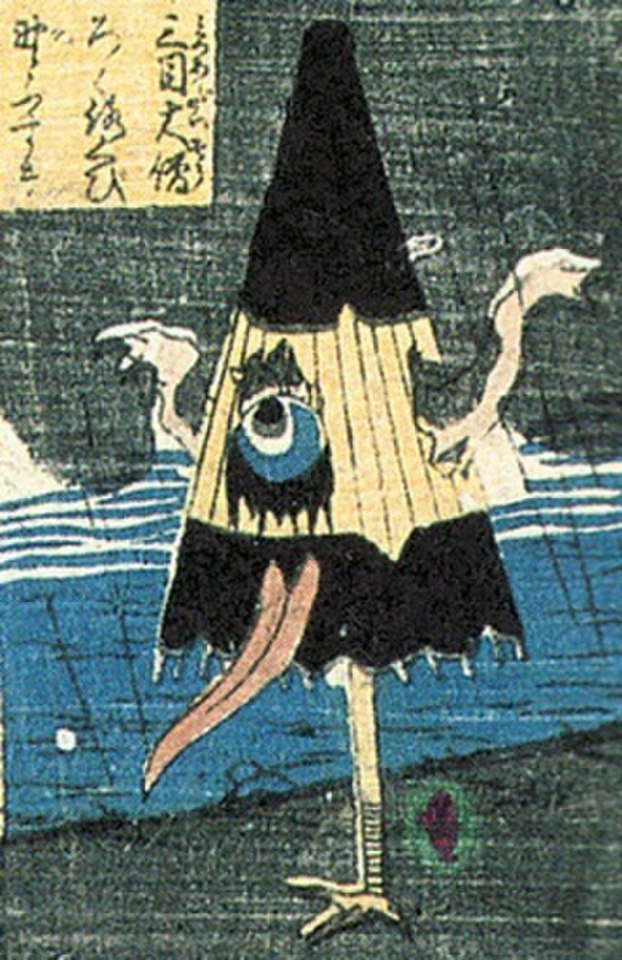
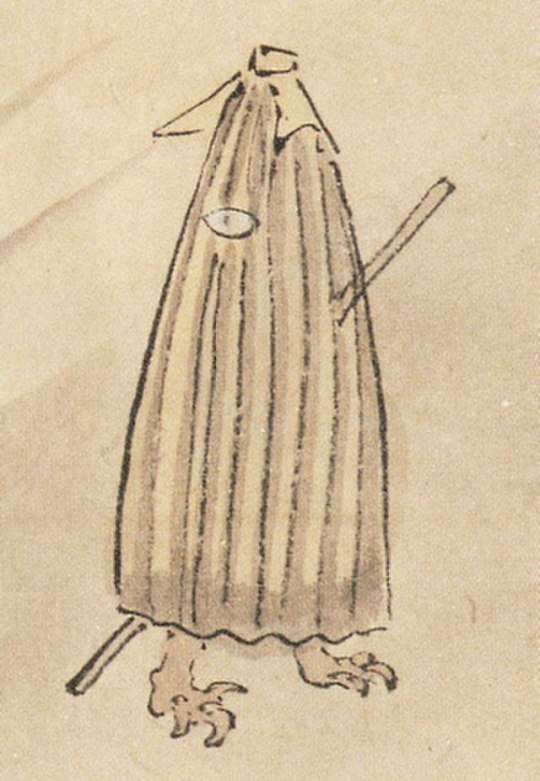
Kasa-Obake
The Kasa-Obake (also kasa-bake or karakasa kozō) is a japanese yokai that typically takes the form of an umbrella with one eye, a long tongue, and either one or two legs. Despite being one of the most recognizable yokai, there is actually very little written about this creature. As far as I can find, there are no accounts of people directly encountering a kasa-obake and no evidence of genuine folk beliefs. Despite this, it has become extremely popular, appearing frequently in pop culture and japanese media (example below).
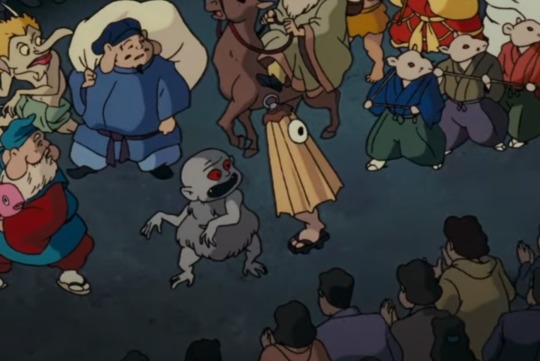
(A kasa-obake from the film Pom Poko)
This yokai is most often portrayed as mischievous, but not especially dangerous. Some believe that kasa-obake are a type of tsukumogami, a household object that receives a soul after existing for one hundred years. Interestingly, an object or animal persisting for a specific number years seems to be a common method by which yokai are created (ex: nekomata and tenko).
The origin of the kasa-obake is uncertain. There are illustrations of umbrella yokai (see below) in scrolls dating as far back as the Muromachi period in Japan (1300s to mid-1500s), though it is unknown whether these are at all related to the kasa-obake.
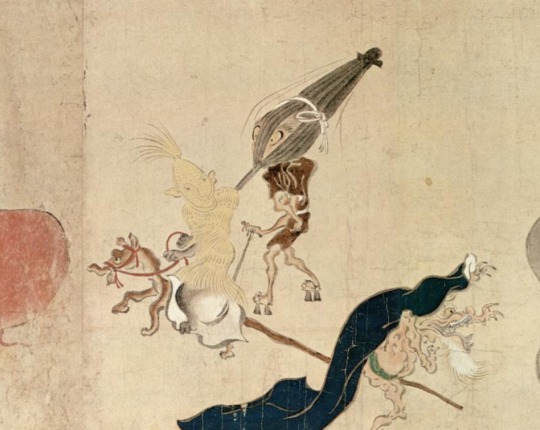
(An umbrella yokai from a Muromachi period scroll depicting the Night Parade of 100 Demons)
Sources:
https://moderntokyotimes.com/art-and-folklore-of-japan-mischievous-nature-of-the-one-legged-umbrella-ghost/
https://yokaitoons.com/index.php/2018/08/21/kasa-obake/
Foster, Michael Dylan, and Shinonome Kijin. “Home.” The Book of Yokai: Mysterious Creatures of Japanese Folklore, 1st ed., University of California Press, 2015, pp. 228–42.
Reider, Noriko T. "The Record of Tool Specters." Japanese Journal of Religious Studies, Suppl.Special Issue: Vernacular Buddhism and Medieval Japanese..., vol. 36, no. 2, 2009, pp. 1-19.
22 notes
·
View notes
Text
Underwater Urban Legends: Jacques Cousteau's Secret Discovery?

(Carthago vol. 3, “Le Monstre de Djibouti”, by Christophe Bec and Milan Jovanovic, 2013)
When I first got interested in ocean creatures as a little girl in the late 90s, we had several oversized white-covered books about Jacques Cousteau's ocean expeditions around the house that my parents let me page through, even though the text was way too small for me to read. A little later on, I read the Cousteau Society's young readers' magazine Dolphin Log/Cousteau Kids every month at the library, especially the selections from Dominique Serafini's comic book adaptations of the Calypso crew's adventures.
As an adult who's still interested in marine science, I've read several of Cousteau's books, and seen some of his documentaries. In 2019, I even got to hear his grandson Fabien speak at an event at the American Museum of Natural History.
Across film, TV, literature, comics, and even music, the Cousteau family’s underwater adventures are pretty well-documented. But one persistent bit of sea-folklore I've come across in various forms and places is an urban legend that at least one adventure wasn't. Somewhere in the world, these stories say, Captain Cousteau saw (or heard) something underwater that was so shocking that he kept it a secret from the world. (Except, presumably, from whoever is repeating the story.)
Could there be any truth behind this fantastic story? What was this "secret discovery"? And where and when did all of this happen? Like most urban legends, there are a lot of conflicting accounts and not a lot of proof.
I'd love to see a site like Skeptoid do a deep dive (heheh) into this story someday, but since they haven't yet, my research is below the cut.
A Secret Discovery?
It's alleged that after a submarine expedition, undersea explorer Jacques Cousteau said, "The world isn't ready for what's down there." (How Stuff Works)
As a reader and a writer, I have to say, this is an excellent pitch for a story. A world-famous explorer who witnessed all kinds of undersea wonders and environmental tragedies choosing to keep a remarkable discovery a secret for some unknown reason? Wouldn't you read that book? I'd read that book!
In fact, I did read that book! The French comic Carthago, first published in 2007 and translated into English in 2014, features a character based on Cousteau named Major Bertrand, a famous ocean explorer who made a discovery so shocking that he not only kept it a secret, but retired and lived the rest of his life onshore afterwards. The actual scene shown in flashback is a beat-by-beat retelling of the "Red Sea Monster" version of the story we'll discuss below. According to an interview with the comic's writer Christophe Bec, that scene (and the comic itself) were inspired by an article in the French paranormal magazine Le Monde de l'un découverte (The World of the Unknown) published in February-March 2001. That article is in French here.
Here are the broad outlines of the story as I've seen it in various places online:
Cousteau surfaces, shaken from a dive, OR
The Calypso crew recover either a shark cage that has been destroyed OR
An underwater camera or hydrophone that has recorded something
Cousteau says some variation on "The world is not ready for what I have seen"
Cousteau orders any film or audio recordings of the incident (taken by either divers, underwater equipment, or film crew aboard the ship) to be either destroyed or suppressed and hidden away in a safe
(Some accounts have people saying they actually saw the incident happen on TV, which is unlikely as I don't think any of Cousteau's documentaries were live broadcasts.)
Cousteau is so shaken by what he saw that he never returns to the site of the incident
The Red Sea Monster
The most famous and detailed version of the story, and the one Carthago adapts, sets the action in the Gulf of Tadjoura off the coast of Djibouti, near where the Red Sea meets the Indian Ocean. Investigating legends of a sea monster in a cove called the Ghoubbet al-Kharab, or Gulf of the Demons, Cousteau's team lowered a camel carcass within a shark cage. When the cage was raised, it had been badly damaged, perhaps even destroyed.

[The Ghoubbet al-Kharab is the little inland bit at left almost cut off from the sea x]
The article in Le Monde de l'un découverte says this incident happened sometime before 26 June 1995, when the secret was revealed by a writer(?) named Stéphane Swirog, and that it had also been discussed on French TV in 1987. (I cannot find any information about a “Stéphane Swirog” online except in reprints of this story, although there is apparently an MMA fighter with that name. Is this one of those hoax articles with backwards names where “Goriws” sound like something hilarious in French that’s lost on me?)
This is a plausible part of the world to set this story, because Cousteau very famously did explore the Red Sea several times! A lot of his film The Silent World was filmed there, and his Conshelf underwater habitat was on the floor of the Red Sea off Sudan. In 2004, Cousteau's son Jean-Michel and grandchildren Fabien and Céline returned to these sites fifty years later for a new documentary you can watch here.
And we know Jacques Cousteau actually DID explore the coast of Djibouti in 1967-68! In his book Life and Death in a Coral Sea (1971), he says that when docked there, his crew, err, heard a strange story...
...we decided to visit the Goubet, a famous gulf of the Red Sea. Before leaving Djibouti that morning, one of our crew had by chance asked a local Arab diver about the Goubet. "Ah, sir," the man had replied, "it is a most extraordinary place. It is bottomless, and it is inhabited by monsters so large that they can drag down lines attached to 200-liter cans. Moreover, in 1963, Commandant Cousteau went there with Fredéric Dumas and his best divers, and they were so terrified by what they saw that they ran away." Naturally, we were eager to see the place in which, according to local gossip, we had earned so ignominious a reputation. I must report, however, that the Goubet was a disappointment. It is an inland sea or gulf that connects with the Red Sea by a narrow pass in which there is a very strong current, running up to seven knots. The surrounding area is very beautiful, and very wild, being dominated by volcanic mountains bare of foliage and marked in shades of red, yellow, and black. Once in the Goubet itself, we lowered the diving saucer to a depth of over six hundred feet without catching sight of even a small monster. The divers then suited up and went down also, but they saw nothing more remarkable than some very large sea urchins. There seemed to be very few fish of any kind. It is my guess that the "Goubet monster" of Arab legend was originally a manta ray, seen by some shepherd from a hill top. Manta rays are plentiful in this area, and it must happen occasionally that they wander into the Goubet and – because the inlet is so narrow and because mantas are not the most intelligent of beasts – have trouble finding their way out again. (Page 42)
(This is one of those "white-covered books" I still own a copy of!)

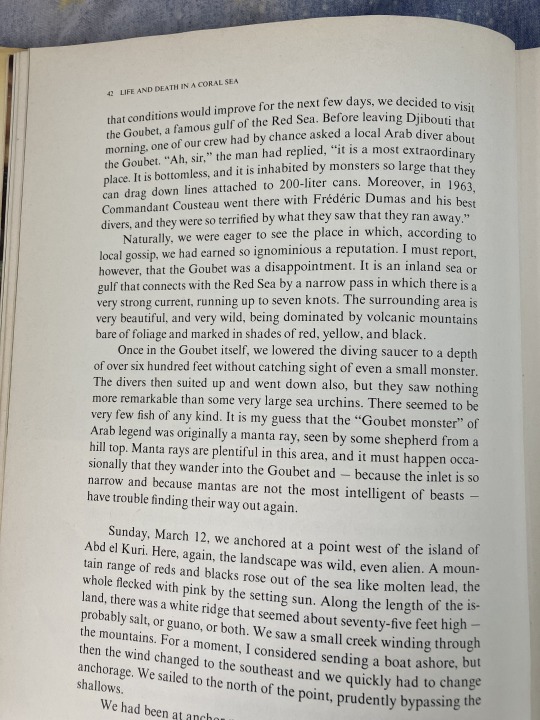
That's right, this story is so old it was told TO Cousteau in the late 1960s! It's the only version of the story he seems to have actually heard and commented on, and it was to deny the monster story.
It strikes me that two of the fearsome feats attributed to the Red Sea Monster— pulling air-filled cans/barrels underwater and destroying a shark cage— are things the shark in Jaws also does. While Peter Benchley’s novel came out in 1974, several years later, he did research sharks when writing it, so I wonder if “pulling barrels underwater” was just a bit of shark lore that was going around in the late 60s.
(At least the way it’s shown in the 1975 movie, the MythBusters showed a great white shark is strong enough to briefly pull barrel floats underwater but not to hold them there.)
The more embellished 2001 article post-dates Jaws and may be inspired by the cage-destruction scene in the film.
The Depths of Lake Tahoe
Apparently, years ago, Cousteau went scuba diving in Lake Tahoe. He emerged from the water shaken, but not with cold. He said, “The world is not ready for what I have seen.” (Jennifer Skene, “Rumors and Truth in Lake Tahoe”)
Another common account of the “secret discovery” story says that it didn’t happen at sea at all, but rather in the depths of landlocked Lake Tahoe, on the California-Nevada border. This is the version of the story most commonly associated with the “the world isn’t ready” quote. The Lake Tahoe version usually keeps things vague, speculating that perhaps Cousteau saw local legendary lake monster Tahoe Tessie OR a layer of hundreds of perfectly-preserved bodies of Chinese railroad workers or mafia victims floating eerily in mid-waters, OR some other mysterious thing too horrific to describe.

[Unspeakable horrors such as dinky maps found on Bing]
Both Tessie and the well-preserved bodies are urban legends seen discussed elsewhere without the Cousteau connection. Other legends speculate that the lake hides sharks, mermaids, an underground tunnel to Pyramid Lake, a crashed WWII bomber, and a fortune in gold bullion. Just your ISO standard set of underwater legends, really.
However, unlike the Red Sea, there is no evidence that Jacques Cousteau ever visited Lake Tahoe, let alone dove there!
According to other explorers who have explored the lake’s depths, the cold, clear waters do provide eerie visibility to the shipwrecks and sunken trees found there. While people have died in and around the lake and bodies are sometimes found, the more sensational claims of uncanny preservation and bodies eerily floating in mid-water, never rising or sinking, do not fit with Lake Tahoe’s known physical conditions.
The Screams of Hell
Indeed, the French diver Jacques Cousteau was swimming over Cuba some years ago, and he heard screaming noises at the bottom of the ocean. ... And Jacques Cousteau was so shaken up by what he had heard in the seas off Cuba, he never swam there again. ... He heard what he believed to be screaming, shouting, people being tortured, just as the Bible teaches. ("Ex-Catholics for Christ")
Yet another version of the story says that Cousteau heard the sounds of agonized screaming underwater, either while diving himself or recorded on a hydrophone, and possibly considered them the screams of souls in hell. These versions of the story tend to be vaguer, not always naming a time or place when this happened. (That version put it in Cuba, another in Greece, others vaguely “somewhere in the Bermuda Triangle”.)
That's probably because this version is just an adaptation of another, more well-known urban legend about Soviet geologists digging into hell and recording screams that has been repeated in various places since the 1980s. (You can see some of the problems with that story at the site linked.)
(Cousteau did explore Cuba’s waters in the mid-1980s as seen in the documentary, Cuba: Waters of Destiny. You won’t hear any screams from Hell in that documentary, but there is a guest appearance from Fidel Castro!)
Another religion-related urban legend about Jacques Cousteau is that he converted to Islam after discovering the Quran was correct about the mixing of the waters of the Red Sea and Indian Ocean. This isn't true, either. In some places I'd seen this repeated in the same context as an equally-untrue claim that Neil Armstrong converted to Islam after hearing the call to prayer on the moon, and misremembered this as a claim Cousteau had heard the call to prayer underwater for a less-disturbing twist on the idea that the secret discovery was something heard underwater rather than seen, but as far as I can tell, that isn't the case.
Bells in Random Order
Do you know Jacques Cousteau? Well, they said on the radio That he hears bells in random order Deep beneath the perfect water ("Perfect Water")
The Blue Öyster Cult song "Perfect Water" has the lyrics above, which may be a reference to the "secret discovery" legend and specifically the above idea that it was a mysterious sound heard underwater. The band is known for having many references to legends, conspiracy theories, and the supernatural in other songs. "Perfect Water" was on the album Club Ninja, released in December 1985, post-dating Life and Death in a Coral Sea but predating the most famous accounts of the “Well to Hell” story. I can't find any other sources talking about Cousteau and mysterious bells.
This website instead thinks the lyrics are referring to Cousteau's actual descriptions of walruses as making sounds similar to bells in his writings and films. You can hear a walrus making a bell sound here.
Ask Me Anything
During an AMA session on Reddit in 2018, Fabien Cousteau (FCNomad) was asked about three different versions of this story (Djibouti, Lake Tahoe, and Fort Peck Reservoir in Montana.) He seemed most familiar with the Lake Tahoe version.
sotpsean: Hello, Mr Cousteau! It's an honour. When I was a child, family lived in Djibouti, Africa,(my father was a French Foreign Legionnaire). There was a local legend about a "sea monster" living in Lac Goubet. I've heard that your Grandfather might have investigated Lac Goubet in search of this "monster". Locals have thought it to be a prehistoric shark cut off from the sea. I've always wondered if someone might be able to shed light on this subject. Have you heard of this? Thanks for doing this AMA! FCNomad: Great to chat with you. French foreign legion? Serious stuff. There are legends of "sea monsters" in every body of water out there. Until we explore them we will not know for sure ;-) Lets go see! [x]
-
HulkVomit: Why did your grandfather never want to dive in Ft Peck Reservoir again? Would you ever come dive in it? Account-002: I am also REALLY curious about this. My Dad thought it was because if the siltyness of the water, combined with a possible encounter with multiple giant catfish/paddlefish that put him off. FCNomad: That does seem plausible and potentially sound due to the potential risks. He was focussed on filmmaking and if you can't see anything its hard to tell a visual story… [x]
-
TeddysGhost: Hi there, I live at Lake Tahoe and it is a common story around here that your grandfather went into the lake once and when he emerged he warned people that the world isn't ready to see what's down there? What do.you know about that story? Is there even a shred of legitimacy and if so what did he see? FCNomad: Ive heard this rumor as well. We were supposed to investigate on a new TV series but we never got the chance… [x]
Conclusions
...yeah, all versions of this story sound pretty fake to me. Sorry.
As Fabien says, almost every body of water has sea and lake monster legends attached to it, because the world’s waters really are mysterious, unpredictable, and dangerous. But over time, your local legendary water monster can become familiar, almost a sort of community mascot.
When reading the archives of The Liberator, a famous anti-slavery newspaper published in Boston in the mid-1800s, I found several articles where the writers referred to the New England sea serpent in these kinds of familiar terms, since to Bostonians it was a “local” monster. They even called it “our American sea serpent”— the children and grandchildren of the Minutemen, still defining their identity as Americans, could boast that England didn’t have such a cool monster.
In modern times, of course, a local monster legend can also be a major tourist attraction. Most of the sites I found repeating the Djibouti and Lake Tahoe versions of the story were… travel sites for Djibouti and Lake Tahoe (especially diving travel sites).
To present your local monster story as “verified” by a famous underwater explorer like Jacques Cousteau makes it sound authentic. It certainly spices things up for people planning their vacations, especially divers. And to say that your local monster scared away a globetrotting adventurer like Cousteau who had faced so many other perils all over the world definitely adds to the “local pride” angle. In Djibouti, a French colony that was having a vote in 1967 about whether to become independent, a story about a local monster scaring away a famous Frenchman may have had an appealing nationalist undertone.
The writer for Le Monde de l'un découverte, however, probably just wanted to tell a rip-roaring sea story. The presumably-French writer, writing for a French magazine, would have been writing for an audience who had grown up following Cousteau’s adventures. Perhaps they combed his writings in search of any mention of sea monsters that could fit in their paranormal magazine, found the passage about Djibouti in Life and Death in a Coral Sea, and created a more sensational version that conveniently left out Cousteau’s own debunking. For an audience who had grown up with Cousteau, what could be more exciting than hearing about one more adventure of their late hero, totally new and unseen, and a discovery so shocking it was being kept secret?
And, like I said, it does make for a great story! No wonder it inspired Christophe Bec to write his own version! And with the decades-long tradition of fictional stories parodying and homaging Jacques Cousteau, I can’t blame you if this piece has inspired you to write your own version of the “secret discovery” story— just please, make it clear that your fiction is fiction.
23 notes
·
View notes
Text

Supernatural & Paranormal Sentences, Vol. 2
(Sentences from various sources for muses exploring the unexplained. Adjust phrasing where needed)
"I think this case is nothing more than a murderer taking advantage of local folklore."
"It's very dangerous to believe people. I haven't for years."
"It's been said that the fear of the unknown is an irrational response to the excesses of the imagination."
"I've always put my trust in the accepted facts. What I saw last night... For the first time in my life, I don't know what to believe."
"I have to confess that I, for one, will be locking my door tonight."
"Creatures like us are not supposed to interfere in your world."
"That's why I like you! Your ideas are weirder than mine!"
"There is still a lot about this that doesn't make sense..."
"Nothing disappears without a trace."
"You ever had the suspicion that you've been abducted by aliens?"
"I heard reports of several UFO sightings in this area last night. Did you see anything?"
"This house is supposed to be haunted."
"I'm assuming you're familiar with the early indications of repressed memory?"
"Maybe some mysteries are never meant to be solved..."
"What the hell? Was that real?"
"I've seen too many things not to believe."
"It's not places which are evil, it's people."
"I can offer you no satisfactory explanation."
"Did you ever look up into the night sky and feel certain that not only was something up there, but it was looking down on you at that exact same moment, and was just as curious about you are you are about it?"
"What would be the chances of someone like me seeing a UFO?"
"Do you believe in the existence of extraterrestrials?"
"Did you see that?"
"You ever experienced a period of missing time?"
"What you are looking at, it exists nowhere in nature. It would have to be, by definition, extraterrestrial."
"It can't be aircraft. Aircraft can't manoeuvre like that."
"I did not say that "people" believe this; I said "conspiracy theorists"."
"Just because I can't explain it, doesn't mean I'm going to believe they were UFOs."
"You put such faith in your science, but the things I've seen, science provides no place to start."
"Are you at all familiar with the phenomenon of cattle mutilations?"
"I hope you're not thinking this has anything to do with government conspiracies or UFOs. "
"I shall never forget what I saw this evening."
"You make an effort to appear conventional, but I know that you share my love of all things bizarre."
"There's something unexplainable here, but it's certainly not unidentifiable."
"You're saying that time disappeared? Time can't just disappear!"
"Fact is, we've got a cannibalised body. Someone - or something - out there is hungry."
"Why are you so determined not to believe me?"
"I thought you'd be pleased that I'd opened myself to extreme possibilities!"
"The government can't control a deficit or manage crime. What makes you think they can plan and execute such an elaborate conspiracy?"
"It's happening again, isn't it?"
#rp meme#rp memes#roleplay meme#roleplay memes#rp prompts#roleplay prompts#sentence starters#supernatural;#assorted;
83 notes
·
View notes
Text
On the Fin Ears or Ear Fins Trope
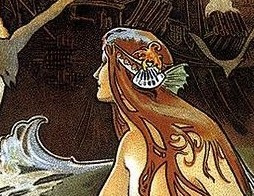
"The Mermaid" detail by Charles Robinson for "Fairy Tales from Hans Christian Andersern" in 1899.
These so-called ear fins or fin ears are often pointed and sometimes webbed ears, at least somewhat, resembling the pectoral fins of fish yet placed on the sides of the head. They are commonly found in many 21st century media of waterfolk. This article dives into this so-called trope a little: https://tvtropes.org/pmwiki/pmwiki.php/Main/EarFins. Ear fins appeal to me very much because their shape looks so FIN-tastic. When I sea ear fins on a waterperson, I immediately think: they shorely are fishy, but abzulutely not in the informal negative sense! The author of any waterperson shorely knows what they are doing when they add these ears.
While one could view it as a rather recent phenomena as of now upon releasing this, it actually does date back in the past. For example, Charles Robinson (1870-1937) created some depictions of ear fins.
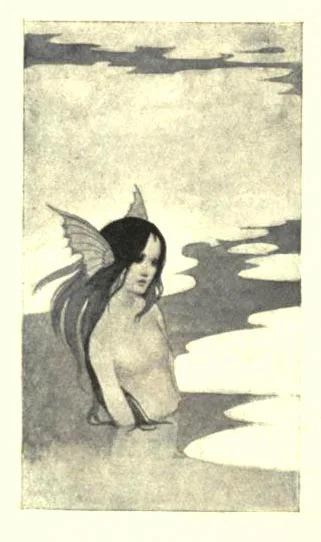
Illustration by Charles Robinson for an illustrated edition of "The Sensitive Plant" in 1911.
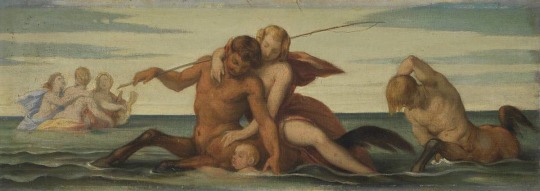
"Tritonenfamilie" by Mortiz von Schwind in ca. 1865. The ichthyocentaur in the center possesses a possible fin ear.
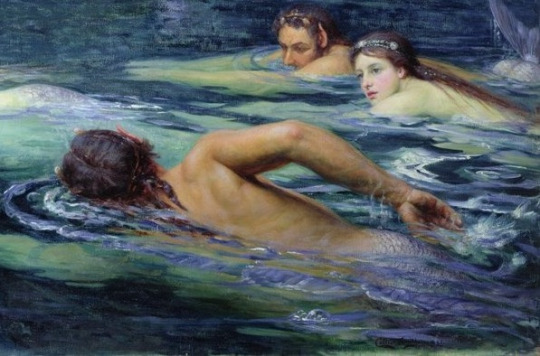
"A Race with Mermaids and Tritons" detail by Collier Twentyman Smithers in 1895.
Other waterpeople's fin ears could look more like pointed ears. Some supposedly exhibited waterfolk specimens had such kinds of ears, for instance. To be honest, some do look like the fin ears that get depicted in the form of a seashell in some 21st century works like Oscar Wilde described the mermaid in his work "The Fisherman and His Soul" with "(...) and like sea-shells were her ears (...)". This may be evident as our ears themselves may resemble the shapes of certain seashells and we also have a spiral organ in our ear which may resemble sea snail's shells.
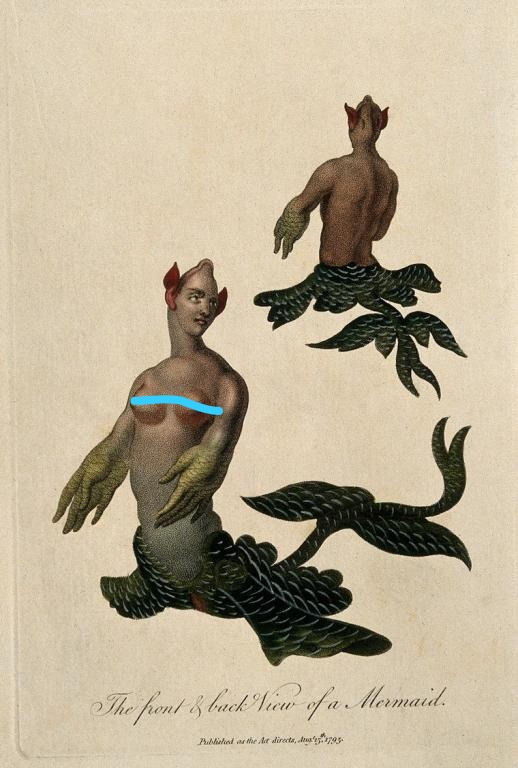
"Mermaid" by John Pass or Paas for Encyclopaedia Londinensis in 1817.
It still not only does date back into the 19th and 20th century. Triton had been supposedly depicted with "Spitzohren", namely "Sharp-Ears" or pointed ears according to "Meyers Großes Konversations-Lexikon" vol. 19 issue six on page 730: https://archive.org/details/meyersgrosseskon19meye/page/730/mode/2up?q=triton
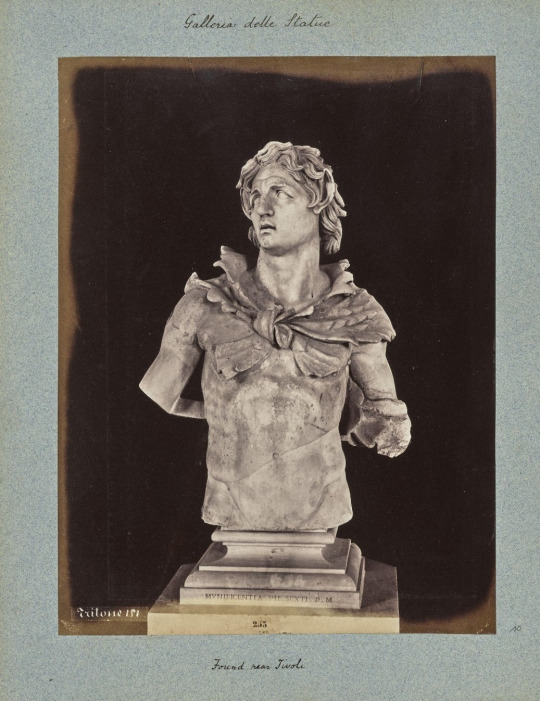
A sculpture of Triton as referenced in "Meyers Großes Konversations-Lexikon". His ears look pointed, but still somewhat round. Sculpture featured in the Gallery of Statues at the Vatican Museums in Vatican City. "Triton" photo by Michele Mang (1840-1909). Vatikan, Museo Pio Clementino, Galleria delle Statue (Nr. 253) from ca. 1865-1870 - Bayerische Staatsgemäldesammlungen - Neue Pinakothek München: https://www.sammlung.pinakothek.de/de/artwork/jWLpmlKGKY CC BY-SA 4.0
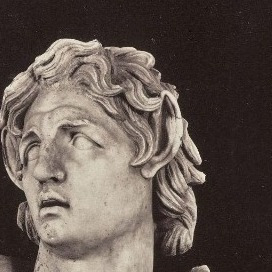
Sometimes, the modern ear fins are thought of to serve as external gills like those of an axolotl. This can be found in one description of the species of Triton, namely the tritones in Greek mythology. Pausanias described them with "breathing organs below their ears" as told accordingly on Theoi: https://www.theoi.com/Pontios/Triton.html.
The watermen called the adaro from the Melanesian mythology of the Solomon Islands also feature "gills below/behind their ears" according to "Encyclopedia of Beasts and Monsters in Myth, Legend and Folklore" by Theresa Bane on page 14: https://books.google.de/books?id=7PYWDAAAQBAJ&pg=PA14&dq=adaro+mythology&hl=de&newbks=1&newbks_redir=0&sa=X&ved=2ahUKEwjHucGn9rOJAxWnxgIHHS2dFHsQ6AF6BAgHEAI#v=onepage&q=adaro%20mythology&f=false, "The Mythical Creatures Bible: The Definitive Guide to Legendary Beings Volume 14" by Brenda Rosen on page 139: https://books.google.de/books?id=mI0vKhZXJqwC&pg=PA139&dq=adaro+mythology&hl=de&newbks=1&newbks_redir=0&sa=X&ved=2ahUKEwjHucGn9rOJAxWnxgIHHS2dFHsQ6AF6BAgOEAI#v=onepage&q=adaro%20mythology&f=false and "Pacific Mythology: An Encyclopedia of Myth and Legend" by Jan Knappert on page 15.
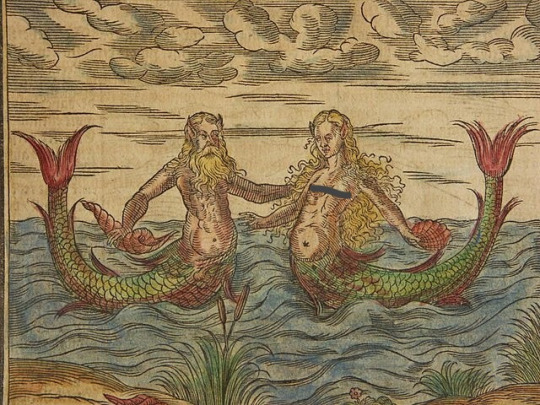
Woodcut by Sebastian Münster in 1600.
Medieval depictions of waterfolk tend to feature such long, pointed ears, more resembling those of horses or dogs. I still do perceive that these might serve as some initial ear fins in some way or another.

Illustration by Conrad Gesner from his "Conradi Gesneri medici Tigurini Historiae animalium" in 1585-1604.
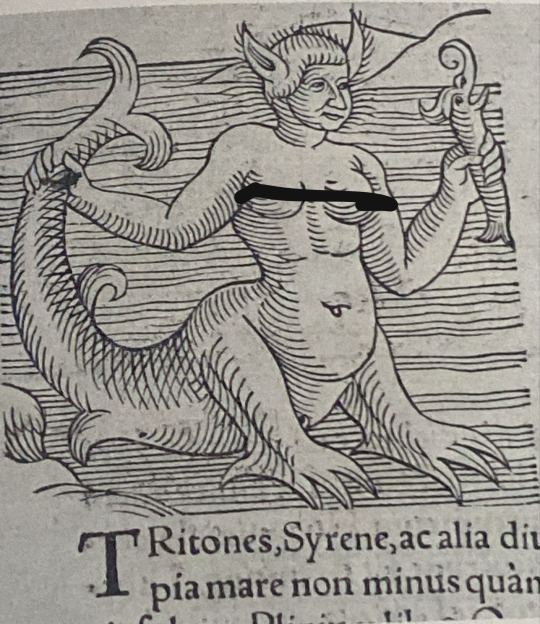
"Merpeople Pair" woodcut detail from "Prodigiorum ac ostentorum chronicon" in 1557.
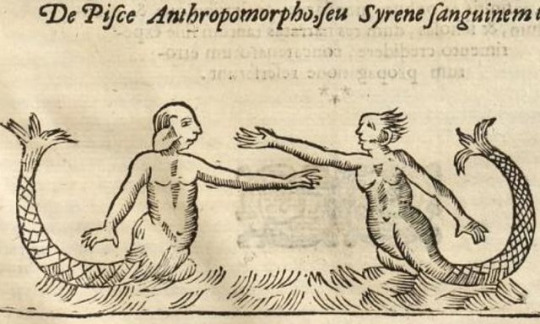
"Lib. III. Pars VI. Caput II. §VI. : De Pisce Anthropomorpho, seu Syrene sanguinem trahente" from "Magnes sive De arte magnetica opus tripartitum" in 1654.
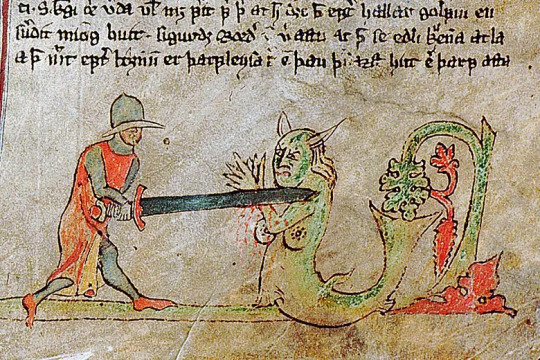
"St. King Olaf fights Margýgr" from "Flateyjarbók" in ca. 1394.
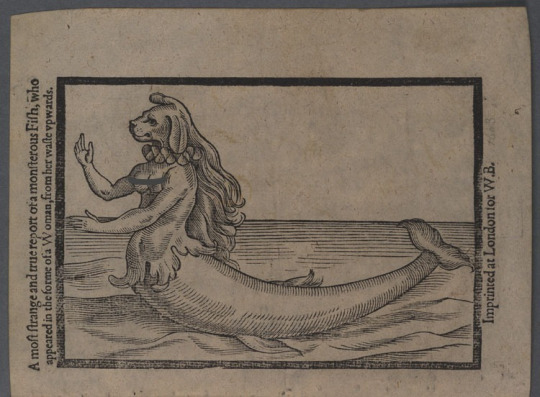
"A most strange and true report of a fish" engraving from 1604 for a supposed mermaid sighted by Thomas Raynold in Wales in 1603.
Thanks for diving into this :>
6 notes
·
View notes
Text

The Fetch [Irish/Scottish folklore]
Imagine unexpectedly meeting a dear friend, who seemingly crossed paths with you by pure coincidence. But something’s wrong: the friend is acting weird and you get the feeling that you’re not talking to someone you’ve known for a long time, but rather an exact copy of that person. This, in old Irish folklore, is the Fetch: an enigmatic being that copies a living person down to the smallest details.
While the Fetch was always regarded as an omen of sorts, John O’ Hanlon made an important addition in his 1870 book ‘Irish Folk Lore’: according to him, the person whose future the Fetch predicts is not the one who sees the omen. Instead, the creature will appear as an exact copy of someone and will then appear to a close friend of the one he copied. This will often be a strangely sudden and mysterious meeting. If this friend sees the Fetch in the morning, this will not affect him, but the person who was copied will live a long and prosperous life. If the friend sees the Fetch at night, the person who was copied will die soon, but the person who sees the apparition will not be affected either way.
According to Feats, belief in the Irish Fetch was also commonly found in Scotland. This claim might have been derived from a statement by O’Hanlon that the Fetch is related to a similar Scottish spirit.
Sources: Kinahan, F., 1983, Armchair Folklore: Yeats and the Textual Sources of “Fairy and Folk Tales of the Irish Peasantry”, Proceedings of the Royal Irish Academy, Section C: Archaeology, Celtic Studies, History, Linguistics, Literature, Vol. 83C, pp. 255-267. Yeats, W., 1993, Writings on Irish Folklore, Legend and Myth, Penguin UK, 496 pp. (this is a collection of Yeats’ writings from the late 19th and early 20th century.) (image source: ‘How They Met Themselves’, 1864 watercolor painting by Dante Rossetti. The painting is not meant to depict the Fetch spirit but I thought it fits well.)
165 notes
·
View notes
Text
Creatures from Folklore: Slavic Region A-D
You ever need different creatures to base things off of, or just want some legends for a setting? Or heck, you ever just want to chuck a creature at someone and say you’ll figure it out? Well, do I have the posts for you. This one will focus on the Slavic Region but I’ll make more at a later date
Ala are considered to be demons of bad weather in several folklore, including that of Bulgarians, Macedonians, and Serbs. Their main purpose is to lead thunderclouds that produce hail towards fields, vineyards, or orchards to either destroy the crops or to loot and take them. They are very voracious and really like to eat children. Though one shouldn’t assume they limit their tastes to Earth, no. They sometimes try to devour the sun and moon which lead to eclipses and if they succeed it means the end of the world. People who encounter one may find their mental and physical health as well as their lives at risk. It is, however, possibly to gain her favor by approaching with trust and respect. These good relationships can be very beneficial since she (the ala) can make those with her favor wealthy and save their lives if they are in danger. Ala can take on many different forms: black wind, giant creatures with no distinct form, a monster either humanlike or snake like witha huge mouth, a female dragon, a raven, various human and animal shapes. Ala can also possess people’s bodies. They live in the clouds or in lakes, springs, hidden remote places as well as caves, inhospitable mountains, forests, or even a huge tree. Usually hostile towards humans, they have powerful enemies capable of defeating them like the dragons.
Alkanost have an incredible voice, capable of making anyone who hears her song might forget everything in their search for paradise. A creature of good who resides in the garden of the gods or whatever version of heaven required, the alkanost has the head and bust of a woman and the rest of the body is that of a bird. Sometimes this creature lays eggs which assist in the changing of winter to spring. Basically she wouldn’t sit on her eggs just dump them into the Ocean-Sea and when they reached the bottom the weather would turn fair. Though i think that takes her out of the running for parenting awards.
Anchutka is a small malevolent spirit, residing most often in water or a swamp. Even without wings, it is capable of flight. One of its nicknames is the one without heels. This is a common theme to look for, as oftentimes evil forces have a limp. Though in some storied this spirit has lost their heels because they got bitten off by a wolf. This spirit is often a sidekick to a water spirit called Vodyanoy, and as such you should never say its name aloud since it will always show up.
Aspid, a type of dragon with a beak and other birdlike elements, resides primarily in the mountains, preferring solitude. When it invades a region, nearly always it caused universal devastation.
Baba Yaga: I’m pretty sure a lot of people know about Baba Yaga, the witch who lives in a hut with chicken legs and goes around in a mortar and pestle. She does carry a broom though, but she only uses it to sweep away her tracks.
Bannik is a spirit who rarely does any good for anyone. A mischievous spirit that has the appearance of an old man with long claws, he’s a spirit that inhabits the banya (steamhouse). Whenever people bathed in the banya, they would always leave on the third or fourth session to let Bannik have his privacy. They would leave him offerings of soup and regularly thank him. Bannik had the power to tell the future and if asked a question he would softly touch the askers back if it was a good future or flay it if it was a not so good future. Oh and Bannik, when angry, would claw off the skin of those who annoyed him. The banya was also the place of Russian childbirth, so there were measures taken to keep him from interfering. Part of the midwife’s job was to keep him away. And with good reason. Legends say that he ate or flayed children. So therefore the midwife would dip stones in the water and throw them in the corner to distract the steamhouse spirit.
Bauk hide in dark places and holes and abandoned houses. There they wait to grab, take away, and devour their victims. They have a clumsy gait and can be scared away by light and noise.
Babay, possibly the same thing as the bubak, isn’t often described so children will come up with what is most terrible for them. But despite this, Baby has been described as a black and crooked old man. When he is descibed he tends to have some traits such as muteness, lacking arms, or walking with a limp. He carries with him a bag and a cane. Baby lives in a forest or a swamp or a garden only to come out at night to walk the streets and scoop up the children he meets. He will walk close to windows and watched the children sleep. If they aren’t he’ll scare them with noises. Or sometimes he even hides under kids beds to take them away if they get up.
Błędnica is a forest demoness, who leads people astray before leaving her victims alone in the midst of the forest to die of starvation or be eaten by animals. She is usually described as a young and pretty girl. The only way to chase her away is to use strong spells or to sacrifice something at home or during your hunt.
Blud is a fairy in Slavic mythology. An evil deity who causes disorientation and leads a person around and around aimlessly.
Bukavac lives in lakes and pools, coming out at night to make a loud noise. A six-legged monster with gnarled horns, it would jump people and animals and strangle them.
Bubak is often represented as a scarecrow with a skeleton as frame, which is connected with darkness, it is a type of boogeymen used to scare children. The skeleton often is describes as wearing a heavy black coat where it hides the children it steals.
Cikavac, a mythical creature from Serbian mythology and it kinda feels like a basilisk but way weirder. This thing is a bird that has a long beak and a pelican-like sack. You can acquire one at the low low price of your sanity and clear face. For you see, in order to get one, you need to take an egg from a black hen which a woman now needs to carry under her armpit for 40 days ( is now a good time to note that chicken eggs hatch after 21 days or so) and one cannot confess, cut nails, wash their face, or pray. After that the cikavac would suck the honey from other people’s beehives and suck milk from other peoples cows and then bring it back to their owner. It would fulfill its owner’s wishes and it would allow its owner to understand the animal language.
Chort, a demon or a humanlike spirit in Slavic folk tradition. They are not exactly evil characters. Yes they try to trick people into selling them their souls in exchange for useless gifts. Yes those people are carried off into hell. But they are sometimes tricked into doing such things as building castle walls in a day. Sometimes is depicted as trying to bring evil characters to hell. A small, hairy man with a tail, horns, and one or two hooves. But due to shapeshifting abilities, the chort is able to appear in nicer forms and tries to trick people while in them. Though these transformations aren’t and can’t be complete, so there’s a way to know if one is dealing with a chort whether it be by small horns in curly black hair or a hoofed leg hidden within high boots. Though they share similarities, a chort is not the devil.
Čuma, aka kuga, is a personification of the plague in Serbo-Croation myths. Typically appears as an old woman wearing white, though in some cases has been depicted as a young woman. Direct mention of them were avoided and were usually referred to by godmother or aunty. According to belief, they lived in a far away land where they came from to infect people. Due to their hatred of dirtiness, if they found a dirty household they would be eager to infect it. Due to this, if a plague appeared,every house and its occupants must be thoroughly cleansed. In addition one could make offerings to of food, clean water, basil, and a comb.
Domovoi are household protectors, generally seen as kind spirits though they would harass the family they protect if said family was rude or unclean. This usually took the form of pulling small pranks until the family corrected their behavior. While domovoi are shape shifters, most depictions show them as small, bearded masculine creatures which are reminiscent of hobgoblins. In order to complete his chores and to fulfill his duty of protecting the house, the domovoi would assume the shape of the head of the household, sometimes working in the yard while the real head of household was asleep. (Guess spirits don’t have to worry about identity theft charges). They were also capable of turning into animals, rarely taking the form of a dog or a cat. Another facet of the domovoi was their ability to act as an oracle. Predictions are as follows
Dancing and laughing= Good fortune would come
Rubbed the bristles of a comb= a wedding would happen soon
Extinguished candles= Misfortune would fall upon the household.
Dziwożona, a type of female swamp demon from Slavic mythology, sometimes called Mamuna or Bognika, who lived in the thickets near rivers and streams and lakes. Thought to appear with foul weather around trees and swamps, they are known for being malicious and dangerous, and usually were previously living humans. Several types of people would be at risk of turning into one after death, such as: midwives, old maids, unmarried mothers, pregnant women who die before giving birth, and abandoned children who were born out of wedlock. Some depictions include an ugly, old woman who had a hairy body, long straight hair, and I quote “breasts so huge she uses them to wash her clothes”. I don’t know what that actually means and I don’t want to find out. She also wore a red hat with a fern twig attached. In case she wasn’t weird enough, she’d watch women with their little children. Just chilling around making the kid sick and making schemes to get the mother away from the kid when she’d replace the kid with one of her own, a foundling/changeling.
#i spent 5 hours on this#you better appreciate me lookigng through a bunch of stuff only to find exactly what was on wikipedia#info post#not a prompt#Creatures from folklore vol I#that's what im gonna call this part#part 1 of...idk 3 4 or 5
30 notes
·
View notes
Note
I appreciate the behind-the-scenes we get into your worldbuilding. It's fun getting to learn random history trivia that must've come from hours of research and Wikipedia rabbit holing, and you seem to be enjoying yourself. Thanks for all the work you put into the game, it really shows!
Awww! Thank you so much!
To be honest, a daily occurrence I have with my friends and family is me bouncing into a room and starting with the line:
'Pub quiz fact for you, did you know...'
The nice thing now is that I have a whole bunch of folks other than my long-suffering nearest and dearest to plague with random bits of antiquated trivia!
For example:
In a textual sources sense it is believed by some that the Werewolf is a largely French originating creature. They had some rather terrifying problems with wolf attacks throughout their history, and this is reflected in their folklore. See the Beast of Gévaudan for a good example.
It's stated in the Oxford Dictionary of English Folklore that:
'Although Gervase of Tilbury wrote in 1211 that werewolves were common throughout England, the examples he then gave are all French'.
However, while I was off looking up two entirely different creatures, namely one 'Raw Head' and one 'Bloody Bones', I came across this extract from around 1550:
Or put a difference betwene their Grādmothers tale of Bloudy bone, Raw head, Bloudelesse and Ware woulf, and the Churches Doctrine of Hell and the Deuill.
John Rastell - A treatise intitled, Beware of M.Iewel. Vol 3
I definitely want to find out more about Bloodless whatever they may be, and interesting that Rastell uses the Werewolf in a similar context of Grandmother's tales as very English figures of Raw Head and Bloody Bones. Does imply, though certainly not in any way prove, that there might be more of a werewolf tradition here than previously suspected.
#MyrkMire#asks#interactive games#hosted games#choice of games#interactive fiction#background research#background work
39 notes
·
View notes
Text
The Thrumpin:
Faery Reapers of the Scottish Borderlands

One creature that I find particularly interesting, and which I thought would be worth talking about a little bit here, is an obscure faery spoken of in the folklore of the Scottish Borderlands; the Thrumpin. Very little is understoof about this spirit, as there are only a couple known historical references to the creature, but it could be simplistically described as a dark inversion of the Guardian Angel. Indeed, the name of this faery likely originates from the Scots word Thrump, meaning ‘to push or jostle,’ which is possibly a reference to the fact that the Thrumpin is an otherworldly force responsible for pushing mortals forward along the path to their ultimate fate.
Thrumpins were said to act as attendant spirits of human fate, with one Thrumpin assigned to every person upon their birth. As such, each of them possesses the power to end the life of the individual they oversee. The reason these faeries were said to act in this capacity remains a mystery, as does the ultimate power behind their assignment in this world, but I do have a theory on the nature of the circumstances that lend themselves to a Thrumpin successfully stealing away the life of its charge. Most of what can be gleaned about the matter comes from a single set of rhyming verses, the origins of which aren’t entirely clear, but seem to represent a gathering of oral folk traditions documented within folklorist Thomas Wilkie’s (1789-1838) essay ‘Old Rites, Ceremonies, and Customs of the Inhabitants of the Southern Counties of Scotland’ which was posthumously published in ‘History of the Berwickshire Naturalist Club, VOL. XXIII’ (1916.) The verses are transcribed as follows:
“When the hullers o' night are loorin',
When the quakens are crimplin' eerie,
When the moon is in the latter fa',
When the oolets are scraughan' drearie,
When the ellere'ed are clumperin'
And the toweries hard are thumpin',
When the bauckie-bird he kisses the yird,
Then, then's the time for thrumpin'.
And gif ye miss the mistic hour,
When spirits have been raised by invokerie,
To thrump ilk faithless wight;
The heavens will gloom like a wizard's smile,
And the foumart will dern his carcase vile,
From all uncannie sight.
For man and beast, by the three sterns' light,
Have little chance to shrive;
Till the sixty are past, and not till the last,
Can man and beast survive.”
To the best of my knowledge, there is no known analyzation of the folk-rhyme cited by Wilkie, and so, though I am far from being an authority on 18th century Scots, or on Scottish folklore in general, I managed to construct my own rendering of the verses into modern English using various Scots dictionaries and preexisting contextual clues. It seems to check out, after plenty of looking over, but I encourage anyone who may know more than me about these subjects to come forward with corrections or additional information. Based on my translations, it can be rendered as:
‘When the mists of night are ominously looming,
When the quaking grass is eerily rustling,
When the moon is below the horizon,
When owlets are screeching drearily,
When those gifted with the Sight are staggering about¹,
When the Powries² are loudly thumping,
When the bat swoops low to the earth³,
Then, it’s the hour of the Thrumpin.
And even if you escape that mystic hour
When risen spirits have been empowered,
To jostle any unfaithful person,
The skies will darken like a Wizard’s Smile,
And the pole-cat will hide his foul carcass,
Away from all uncanny watchers.
For men and beasts, beneath the light of Orion’s Belt,
Have little hope for penance;
Until the hour is up, but not a minute sooner,
Will a man or beast go on living.’
[¹ This most likely describes a Seer—or Elleree—so thoroughly stricken by an episode of preternatural vision that they are reduced to stumbling around as if drunk on the Sight.]
[² This is likely a reference to the creature known as the Redcap—which has also been called the Powry—or more specifically, the Dunter—a Redcap-like goblin which haunts old castles, towers, dungeons, and forts making ominous sounds.]
[³ A European folk belief states that seeing a Bat swoop low to the Earth before flying upwards again means that the Witching Hour has come.]
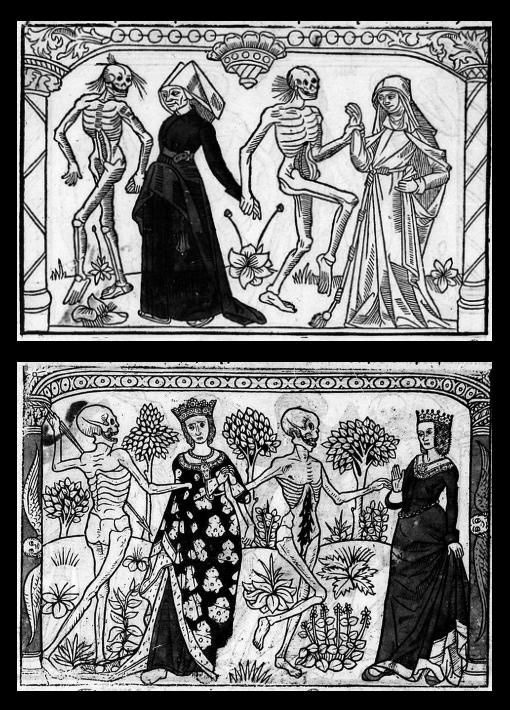
Another variant of this rhyme cited in Wilkie’s essay can be found in William Henderson’s 1866 book ‘Notes on the Folk-lore of the Northern Counties of England and the Borders’. Though it contained several slight linguistic differences from Willie's version, it appears to translate in virtually identical ways. As put in Henderson's account:
“... in the South of Scotland every person was supposed to be attended by a sprite, who had the power of taking away his life — a strange perversion of the doctrine of Guardian Angels. This is called by the old name of "Thrumpin"..."
While it’s entirely plausible that the poetic lines above constitute a generalized construction of eerie presages, in order to serve as a spooky backdrop for discussion of the Thrumpin, frankly seems improbable to me. Based on the content of these verses, one could posit that the occurrence and conjunction of omens, such as those sorts listed in the rhyme, portend the death-by-Thrumpin of whomever should bear witness to them. And based on the context of the declarations in Wilkie’s essay, I further postulate that the these verses may describe a ‘countdown,’ of sorts, that begins upon the convergence of the aforementioned omens, and which marks the last hour of life afforded to a person by their Thrumpin, before the reaping.
With such scant evidence of the Thrumpin’s role in history and folklore left for us to scrutinize, these claims obviously represent conjecture. However, whatever the case may be, the memory of the Thrumpin and its station as Guardian Reaper lives on, in Scotland, and beyond. In fact, the 1994 play ‘The Skriker,’ by Caryl Curchill, even makes mention of them. In the play—which tells the story of an ancient faery who transforms into numerous forms throughout the story, as it pursues a pair of teenage mothers whom it aims to befriend, seduce and entrap—there is a scene that features a group of businessmen discussing their affairs in a meeting while, unbeknownst to them, their Thrumpins carry on a conversation of their own—presumably about the ways they intend to kill their mortal assignments.
It's fascinating to think of all the spirirts we've forgotten—at least in part—over the ages. It's also why I love working to piece together historical accounts of obscure beings, such as the Thrumpin.

—
Sources:
‘Old Rites, Ceremonies, and Customs of the Inhabitants of the Southern Counties of Scotland’ by Thomas Wilkie (1789-1838)
‘History of the Berwickshire Naturalist Club, VOL. XXIII’ (1916)
‘Encyclopedia of Fairies: Hobgoblins, Brownies, Bogies, & Other Supernatural Creatures’ by Katharine M. Briggs (1976)
‘William Henderson’s Folk-Lore and Thomas Wilkie’s “Old Rites”: A comparative approach’ by J.B. Smith (2011)
‘Notes on the Folk-Lore of the Northern Counties of England and the Borders’ by William Henderson (1866)
‘The Skriker’ by Caryl Churchill (1994)
Art:
'L'Ankou de la chapelle Saint-Gildas à Carnoet' — Slokeine, Flickr (2021)
'La Danse Macabre' — Guy Marchant (1485)
'Angel of Death' — Evelyn De Morgan (1881)
#Thrumpin#faery#faeries#faerie folk#fair folk#fairies#traditional folklore#Scottish folklore#Old Rites Ceremonies and Customs of the Inhabitants of the Southern Counties of Scotland#History of the Berwickshire Naturalist Club VOL. XXIII#Encyclopedia of Fairies: Hobgoblins Brownies Bogies & Other Supernatural Creatures#Notes on the Folk-Lore of the Northern Counties of England and the Borders#The Skriker#Thomas Wilkie#Katharine M. Briggs#William Henderson#Caryl Churchill#lailoken
408 notes
·
View notes
Text
Down the rabbit peryton hole
I love folkloric animals, especially pretty ones, so I also love what I have come to know as the peryton. The peryton is a hybrid animal, part stag/deer and part bird (how much bird depends on the source). The name ‘peryton’ however seems to originate from one single source: Jorge Luis Borges’ Book of Imaginary Beings (1957). Apart from giving these winged deer a name, Borges also describes some absolutely buck wild characteristics and folkloric origins:
Perytons have a deer’s head and legs and a bird’s body and wings.
They usually have dark green and occasionally light blue feathers.
They eat dry earth.
They used to live in Atlantis.
Their shadow looks like that of a human, suggesting that they are the spirits of those who died far away from home and out of reach of their care of their gods.
They are mortal enemies of the human race and if they kill a person they win back the favour of their gods and finally get their own shadow.
They are impervious to weapons but can only kill a single person.
They fly in flocks and can swoop down on ships, gruesomely attacking the crew.
The Sibyl of Erythraea foretold that the city of Rome would be destroyed by perytons.
I can find absolutely no corroboration of this folklore anywhere. The sources Borge gives (without title or clear author) are a medieval manuscript based on a Greek text, both of which have been lost and/or destroyed. In Tony Allan’s The Mythic Bestiary (2008) he calls the peryton “originating from Borge’s active imagination and love for scientific jokes.”
But winged stags did feature in art far before Borges.
For the Scythians (an ancient nomadic people of Eurasia, inhabiting the region of Scythia from the 7th century BC until the 1st century AD) the stag was clearly an important creature and/or symbol (Jacobson, 1983, pp. 68-120; Loehr, 1955, pp. 63-76). They are usually portrayed with elaborate antlers, but sometimes also with wings:
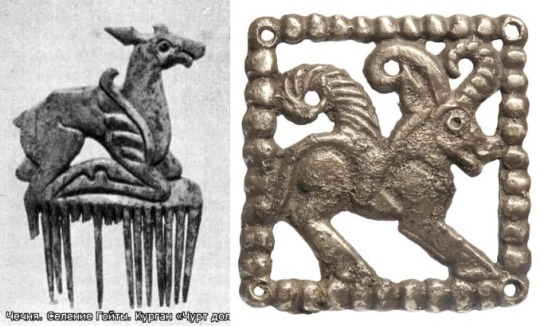
They also show up in heraldry too, for instance on the crest of the British Earls of Granville (A Complete Guide to Heraldry, 1909, Chapter 12). And as a symbol of power for the French King Charles VII, used in several tapestries (Hanley, 1983, p. 39-40). It shows up in Claude Paradin’s Devises Héroïques from 1551, and in Jean Froissart’s illuminated manuscript Chroniques (Vol. IV, part 1, c.1470-1472):
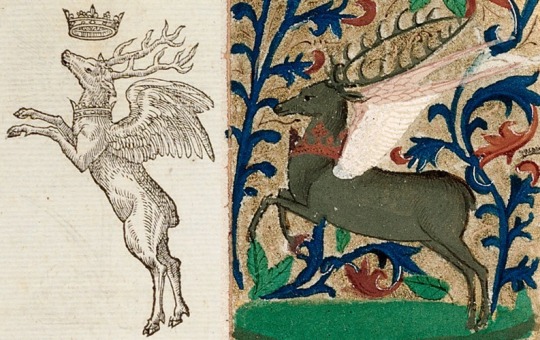
I have seen it suggested that winged stags were a “purely artistic” addition to heraldry, and never part of folkloric belief (Johnston, 2011, Vol. 1, p. 512), but just because there are no recorded stories about a beast does not mean they never existed. Many of the more domestic hybrid animals of folklore do not have clear legends or origin stories. They were just thought to exist, sometimes, especially when walking home late at night. It is very clear, however, that these winged stags did not look like the half-bird, green-feathered peryton and were, if anything, symbols of majestic power. Not feral monsters out for human blood.
So I am beginning to believe that while winged stags have been around for a long time, they probably find Borges’ perytons give them a really bad name.
#peryton#winged deer#winged stag#medieval folklore#Jorge Luis Borges#I may have gotten a wee bit hyperfocussed on this last night#it's been bothering me for ages#next up is a deep dive into Borges book#because dammit where did you base this all on
168 notes
·
View notes
Text
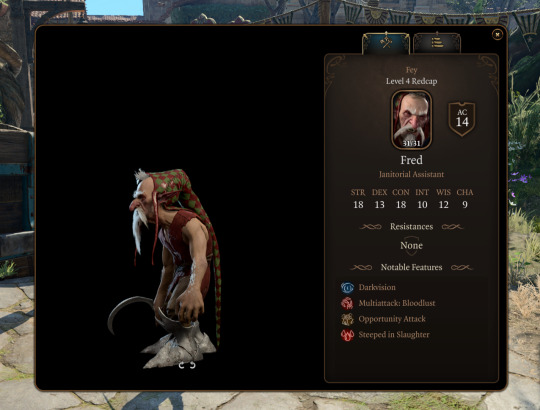
Folklore in Modern Media #1: Redcaps in Baldur's Gate 3
Baldur's Gate 3 is huge right now so this seems like a good place to start a series on depictions of folklore creatures in modern media. In classic folklore, a redcap is a malevolent type of goblin or spirit that lives in abandoned castles along the Scottish borders. They resemble old men wearing iron boots and pointed red hats (photo below from Fairies by Brian Froud). According to some folklore, redcaps dye their caps in the blood of their victims and that if their caps ever dry out, they perish.
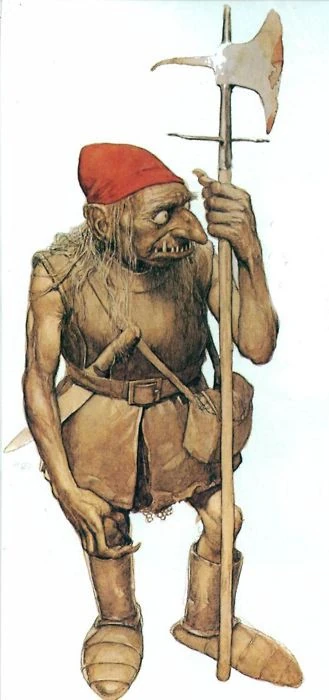
Redcaps are said to possess supernatural speed and strength. This strength combined with the redcap's violent nature makes these creatures very dangerous. According to William Henderson's Notes on the Folk-lore of the Northern Counties and Borders redcaps are known to carry pikes for weapons or simply throw stones from their castles at unwelcome guests. There is a trick, however, to defeating a redcap. One must recite lines of scripture and a redcap will flee or go up in flames.
In Baldur's Gate 3 the redcap matches the classic description of the folkloric goblin almost perfectly: pointed red cap, small stature, old wizened features, iron shoes, malicious personality. They also have high strength and an ability called ironbound pursuit which accurately convey the supernatural strength and speed this creature is known for.
One major difference lies in the creature's choice of weapon. In both BG3 and 5th edition Dungeons and Dragons (on which BG3 is based) the redcap uses a sickle rather than a pike. Another difference can be found in where the redcaps in BG3 are encountered. Some are found outside of a hag's hut and appear to be her servants. Others are found in a circus and, similarly, work there as servants. This is very different from the classic folklore of the lone spirit haunting an abandoned castle. There is precedent, however, for redcaps playing the role of servant. In Minstrelsy of the Scottish Border (Vol. 4) Walter Scott describes a specific redcap who was the familiar to a Scottish noble named William de Soulis.
I actually think the redcap is very well represented in BG3 (and by extension D&D) and it's nice to see a somewhat niche creature from Scottish folklore get the attention it deserves!
Sources:
Image:
Screenshot from Baldur's Gate 3
Alan Lee and Brian Froud. Faeries. 1978
Information:
William Henderson. Notes on the Folk-lore of the Northern Counties and Borders. 1866
Katherine Briggs. An Encyclopedia of Fairies. 1976
Walter Scott. Border Minstrelsy (Vol. 4). 1849
21 notes
·
View notes
Text
2021 Reading Log, pt. 25
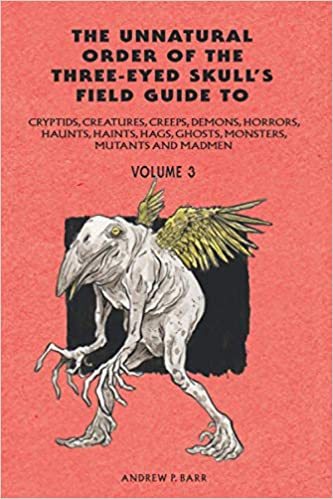
121. The Unnatural Order of the Three Eyed Skull’s Field Guide, Vol. 3by Andrew P. Barr. This appears to be the last planned volume, as the fictional Andrew Barr is dead within the realm of the book. Of course, posthumously discovered notes, or even spirit writings, are staples of the horror milieu @andrewbarrillustrator is working in, and I would be delighted to see his remaining Monsters by Mail collected into a fourth volume. The creatures this time around include a smattering of gill-men and one or two folkloric entities, but are almost entirely original. Many of the sighting dates are also from 2020, which gives a great imagination hook. While many people were keeping their heads down during the pandemic, stranger things were crawling out of the woodwork.
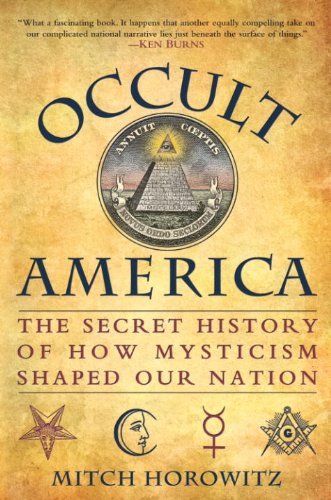
121a. Occult America by Mitch Horowitz. I gave up on this fifty pages in. Although its main thesis is interesting (magical studies are intertwined with American religious life, especially for the various new religions that originated in the states), it cannot stick to a single thread for long enough to follow it through. It jumps wildly around in time and space in each chapter, not going in any particular apparent order in presenting its ideas. It whitewashes the inherent racism of beliefs like the presence of a “superior civilization” predating the American Indians, or Madame Blatavsky’s white supremacy. And it paints the Public Universal Friend as female, and refers to them by their birth name, instead of respecting the genderless presentation that was a major part of their spiritual presence. I would love to read a good book on the influence of the Burned Over District and occultism in American history. But this isn’t it.
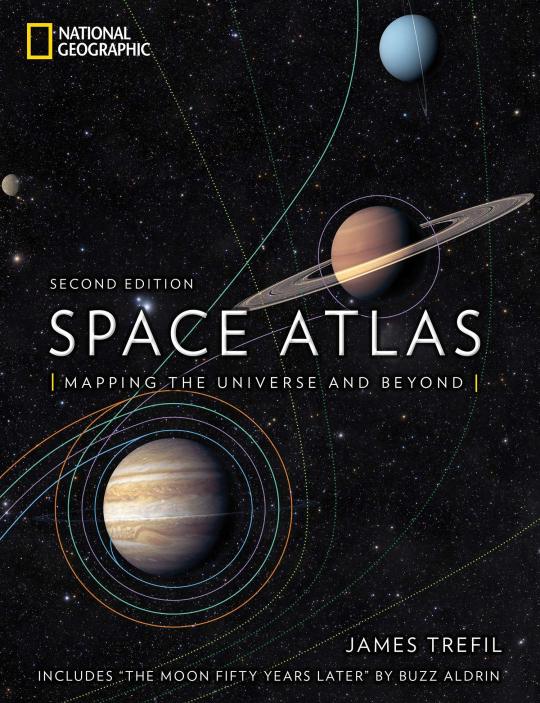
122. Space Atlas, Second Edition by James Trefil. This is a very handsome volume put together by the National Geographic Society, with global views of all of the planets, some of the dwarf planets and moons, maps of the night sky and the galaxy, and more. Each chapter is extensively illustrated with photos and artistic rendering, and there are multiple sidebars highlighting the lives and accomplishments of astronomers and cosmologists. The book does abandon the “atlas” format in the last third, talking about the life cycle of stars, the Big Bang, and string theory, among other concepts. The book begins with a lengthy foreword by Buzz Aldrin, discussing the Apollo program and his plans to build long term research stations on the Moon and Mars. It’s somewhat self-aggrandizing, but I figure if anyone deserves to be self-aggrandizing, it’s someone who walked on the Moon.
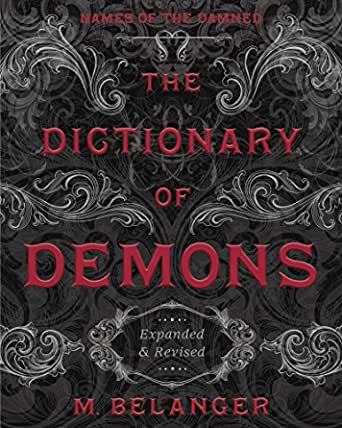
123. The Dictionary of Demons: Expanded and Revised by M. Belanger. This is a book that’s been on my radar for a while, and I finally managed to get myself a copy when the second edition was released in a reasonably priced paperback. It’s an A-Z guide to the names of demons, mostly obtained through grimoires, but also including biblical, apocryphal and a few demons obtained through witch trial records. There’s a lot of overlap between sources, and the cross-referencing isn’t perfect, but it’s pretty good. Appendices and the introduction explain ritual magic in general and the traditions of binding and extorting demons in particular, as well as summarize the zodiac, planetary and other themes of the demons within. Recommended for anyone interested in fiends, magical history or just getting a collection of weird names. Although, personally, I am fondest of the hosts of Hell that have names that are super mundane to modern ears. Poor Amy, Darek, Leonard and Zach…

124. The Sirens of Mars by Sarah Stewart Johnson. This is another “popular science as memoir” two-in-one book, although it’s heavier on the science and lighter on the memoir than say, The Book of Eels. And since this is the memoir of a professor who’s worked on three Mars rovers, the overlap between the two subtopics is pretty strong. Johnson covers the history of people’s obsession with the idea of life on Mars, and how that has been altered and expectations shifted over the course of the various scientific expeditions since the 1960s. Johnson is an excellent writer, and I would be curious to see if she writes another book for wide audiences—she has a knack for explaining sedimentation and mineralization processes in interesting, readable ways.

125. Drunk by Edward Slingerland. This book supposes to tell the story about how intoxication, and alcohol use particularly, is an adaptive trait to humans and a cornerstone of how our civilization works. It does not succeed especially well. Basically, it’s built on a house of cards—it supposes that human evolution both works in concrete, goal-oriented ways and very quickly. It also has a real issue with whether non-human animals are supposed to be genetic automata and we’re unique, or if studying non-human animals can give us insights into human psychology and neurochemistry. It feels like he’s trying to have it both ways. Some of the things it has to say about history and comparative religion are interesting, but the biological framework doesn’t stand up. It’s worth pointing out that of the glowing pull quotes on the back, none of them are from evolutionary biologists or animal behavior specialists. An entertaining read, but should be taken with more than a grain of salt.
37 notes
·
View notes
Photo

✰ BEST OF THE BEST REASONS TO WRITE FUCKIN’ RECORD REVIEWS IN 2019 ✰
It’s that time again: let’s feast from 2019′s Grapevine That Is Never Pruned with 21 (+ approximately 277 more) of the BEST OF THE BEST REASONS TO WRITE FUCKIN’ RECORD REVIEWS IN 2019! ✰ 7th ANNIVERSARY ✰
<All long playing vinyl records unless otherwise noted...& many cassettes>
✰ ✰ ✰ ✰ ✰ ✰ ✰ ✰ ✰ ✰ TOP 21 ✰ ✰ ✰ ✰ ✰ ✰ ✰ ✰ ✰ ✰
✰ TAIWAN HOUSING PROJECT Sub-Language Trustees (ever/never) ✰
✰ SAMANTHA RIOTT Bloodletting download (self-released)
✰ PAULA GARCIA STONE Undercurrent cd (Linear Obsessional, UK)
✰ POSSIBLE HUMANS Everybody Split (Trouble In Mind)
✰ WILLIAM HENRY MEUNG cassette FMerror (chemical imbalance., Australia)
✰ LEILA BORDREUIL Headflush (Catch Wave Ltd)
✰ LEIGHTON CRAIG Diamond Eye (Bruit Direct Disques, France)
�� KNITTED ABYSS Bad Lassies (Paradise Daily, Australia)
✰ WEAK SIGNAL LP1 (Mag Mag)
✰ TOM OF ENGLAND Sex Monk Blues (L.I.E.S.)
✰ DRY CLEANING Boundary Road Snacks And Drinks & Sweet Princess LP (It’s OK, UK)
✰ 75 DOLLAR BILL I Was Real double LP (Thin Wrist Recordings)
✰ DARK BLUE Victory Is Rated (12XU)
✰ KALI MALONE The Sacrificial Code 3 cd (iDEAL Recordings, Sweden)
✰ SHABAZZ MYSTIK Chant D’Lâme (Off, Belgium)
✰ LONG HOTS Give And Take 7” (Third Man)
✰ AMIRTHA KIDAMBI & LEA BERTUCCI Phase Eclipse cassette (Astral Spirits)
✰ CHRIS BROKAW End Of The Night (VDSQ)
✰ SPIRAL WAVE NOMADS Spiral Wave Nomads (Twin Lakes/Feeding Tube)
✰ HAMA Houmeissa (Sahel Sounds)
✰ YL HOOI Untitled cassette (Altered States Tapes, Australia)

JEANINES Jeanines (Slumberland)
ARTEFACTOS DE DOLOR La Niña double LP (Pain Artifacts)
U-BAHN U-Bahn (Future Folklore, France)
MDOU MOCTAR Ilana: The Creator (Sahel Sounds)
STEFAN CHRISTENSEN The Upcoming Flame (bruit direct disques, France)
TYSHAWN SOREY & MARILYN CRISPELL The Adornment Of Time cd (Pi Recordings)
ALE HOP Apophenia (Buh Records, Peru)
TIM PANARETOS Submergence cd-r (chemical imbalance., Australia) & Opposites End download (self-released, Australia)
KATE CARR City Of Bridges download (Longform Editions, Australia)
WRITHING SQUARES Out Of The Ether (Trouble In Mind)
MY NORTH EYE (My) North Eye (2011) cd-r (Reverb Worship, France)
PINOCCHIO Pinocchio ep (Toxic State)
BRIDGET HAYDEN Soil And Song cassette (Synchronise Witches, UK) [comes with Karen Dalton fanzine!]
The COWBOYS The Bottom Of A Rotten Flower (Feel It Records)
OLUMPUS Caucus & Surplus downloads (both stabbies, etc., New Zealand)
CHUCK CLEAVER Send Aid (Shake It!)
JOSÉ DIAS After Silence, Vol. 1. cd (Clean Feed, Portugal)
KNIFE WIFE Family Party cassette (Sister Polygon)

TRAMPOLINE TEAM Trampoline Team (HoZac)
KATE CARR Heatwave cassette (self-released, UK)
SEBASTIEN STH BISET Islæd cd (Mnóad, Belgium)
PHAROAH CHROMIUM Eros + Massacre (Scum Yr Earth, France)
JOSEPH ALLRED Aspirant cassette (Garden Portal Tapes) & O, Meadowlark (Feeding Tube)
ANDREA BORGHI Tistre cassette (Dinzu Artefacts)
MOPE GROOVES Desire (See My Friends Records)
JOSHUA ABRAMS & NATURAL INFORMATION SOCIETY Mandatory Reality (Eremite)
SOFIE BIRCH Island Alchemy cassette (Constellation Tatsu)
VOYAGE DATA Voyage Data cassette (Econore, Germany)
JONNY COUCH Mystery Man (Damages Sofa)
FISCHERLE Gmatwacz cassette (Czaszka, UK)
ROCKET 808 Rocket 808 (12XU)

LINDA TRIP Sad Bangers cassette (Superdreamer)
MATTHEW J. ROLIN Matthew J. Rolin (Feeding Tube Records)
STEKKERDOOS Kalendar cassette (No Rent)
IAN HAWGOOD 光 (Home Normal, Japan)
ÀLEX REVIRIEGO • DISCORDIAN STRING ENSEMBLE Incerto For Doublebass And Strings download (Discordian, Spain)
JULIA KENT Temporal cd (The Leaf Label, UK)
NAPS Better To Give cassette (Gertrude Tapes)
TERROR OF THE DEEP The A-Team cassette (Melted Ice Cream, New Zealand)
CLAIRE ROUSAY Friends cassette (Never Anything)
ANNA SUBIRIANA • POL PADRÓS • JOAN ANTONI PICH Brull’s Bet download (Discordian, Spain)
HAKOBUNE A Fan, Strings, and Two Guitars cassette (Patient Sounds)
LORI GOLDSTON Things Opening (Second Editions, Germany)

The RESONARS No Exit (Trouble In Mind)
MARCIA BASSETT • MANUEL MOTA • MARGARIDA GARCIA Here They Rest Immobile (Yew)
URANIUM CLUB The Cosmo Cleaners: The Higher Calling Of Business Provocateurs (Fashionable Idiots/Static Shock, UK)
THE COOL GREENHOUSE “Crap Cardboard Pet” 7” (Hidden Bay Records, France)
ROB NOYES “You Are Tired”/“Nightmare Study” 7” (Market Square Recordings, UK)
TOM LÖNNQVIST Häviävän Pieni Osa (Guggenhavn Archive, Sweden)
GOTOBEDS Debt Begins At 30 (Sub Pop)
GREG KELLEY/ROB NOYES Greg Kelley/Rob Noyes split cassette (self-released)
DEAD SEA APES The Free Territory double LP (Feeding Tube Records)
DRAGGS Draggs cassette (Slime Street, Australia)
SPRAY PAINT Into The Country (12XU)
SPF Paul’s McCartney
2 CHEVRONS No Rules In Outta Space cassette (Albert’s Basement, Australia)
DARK TEA Dark Tea (Fire Talk)

TERRINE Live At Home cassette (Econore, Germany)
The SNAKES The Snakes (Anti Fade, Australia)
LIVE SKULL Saturday Night Massacre (Bronson Recordings, Italy)
ELKHORN Sun Cycle/Elk Jam 2 LP (Feeding Tube)
MESSRS Messrs 12” (Heel Turn Records)
VIRGINIA PLAIN Strange Game (All Hands Electric)
JEN KUTLER Dismbodied (EyeVee)
MOR AIR Life Behind Glass cassette (Genot Centre, Czech Republic)
CIA DEBUTANTE The Landlord (Siltbreeze)
JOSÉ DIAS After Silence, Volume 1 cd (Celan Feed, Portugal)
LAURA LUNA CASTILLO Folksonomies cassette (Cudighi Records)
THE GIRL IN TIMES NEW VIKING The Girl In Times New Viking (The Fah-Q Catalog)
43 ODES 43 Odes cassette (Eiderdown)
OOF Vanity Plate cassette & EGO cassette (both Fuzzy Warbles cassettes)
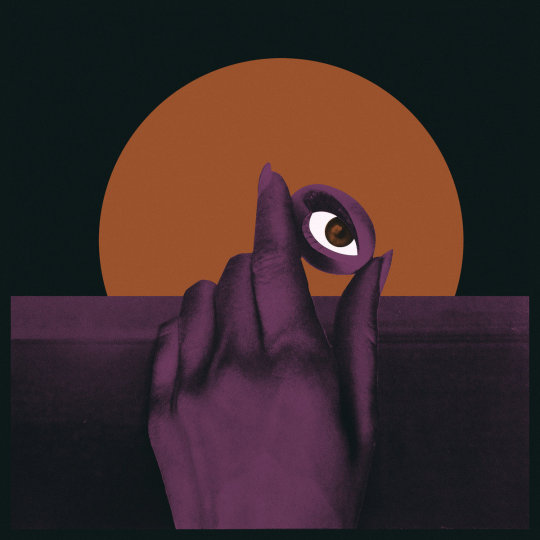
ORGUE AGNÈS A Une Gorge (three:four, Switzerland; Standard In-Fi - 2018)
MICHAEL MORLEY Heavens Idleness Awaits 2 LP (Thin Wrist Recordings)
CHRISTINA KUBISCH Schall Und Klang cd (Fragment Factory, Germany)
HUNTED CREATURES Sleep Weed cassette (White Reeves Productions)
UNITED WATERS Coma To Coma (Drawing Room Records)
JULIUS MENARD Hr cassette (Econore, Germany)
GEE TEE Chromo-Zone download (self/released, Australia)
AARON RUSSELL Coral Music cassette (Gertrude Tapes)
9TH HOUSE Planetary EP 12” (Hot Haus, UK)
SCAN Scan 7” ep (Drugfront)
The HECKS My Star (Trouble In Mind)

ALINA PETROVA & KIRA WEINSTEIN Sad Ko cassette (Never Anything)
HIEROPHANTS Spitting Out Moonlight (Anti Fade, Australia)
NOTS 3 (Goner)
P WITS The Desire and Pursuit of The Whole cassette (chemical imbalance., Australia)
GOLDEN PELICANS Grinding For Gruel (12XU)
TOPDOWN DIALECTIC Vol. 2 (Peak Oil)
M. SAGE Catch A Blessing (Geographic North)
ECHO OHS Wild Weeds 12” (1:12 Records, New Zealand)
CIVIC Selling, Sucking, Blackmail Bribes 7" (Total Punk)
WENDY EISENBERG & SHANE PARRISH Nervous Systems (Verses)
KNEELING IN PISS Tour De Force cassette (The Fah-Q Catalog)
s.soo Tyman download (New York Haunted, Netherlands)
WSCHÓD Wschód cd (Clean Feed, Portugal)

PREENING Gang Laughter (Digital Regress)
CLARICE JENSEN Drone Studies cassette (Geographic North)
MARBLED EYE Beat Sessions, Vol. 8 cassette (Shout Recordings)
STEVE MOORE Steve Moore 12” (L.I.E.S)
The SELVA Canícula Rosa cd (Clean Feed, Australia)
PROGRAM Show Me 12” (Anti Fade, Australia)
SLUMB PARTY Spending Money (Drunken Sailor, UK)
EUN-JUNG KIM & CHARLIE COLLINS Shining Days cd (Linear Obsessional, UK)
NEON Neon 12” (Square One Again)
CUCINA POVERA Zoom (Night School, Scotland)
PAULA SHOCRON & PABLO DÍAZ with GUILLERMO GREGORIO Díalogos cd (Fundacja Słuchaj, Poland)

MY NORTH EYE / LE GOÛT ACIDE DES CONSERVATOURS MNE • L / G / A / D / C split cassette ([Equilibre Fragile], France)
The WOOLEN MEN Human To Human (Dog’s Table)
PIERCE WARNECKE & LOUIS LAURAIN
Phonotypic Plasticity cassette (Astral Spirits)
BIG QUIET Interesting Times (Unblinking Ear)
SEAN ALI • LEILA BORDREUIL • JOANNA MATTREY I Used to Sing So Lyrical cassette (Astral Spirits)
POWDER Powder In Space cd (Beats In Space)
MUKQS Jaki Crush cassette (No Rent)
DENNIS GONZALEZ & DEREK ROGERS Certain Aspects cd (Marginal Frequency)
PONT-À-MOUSSON Bye Bye Mirello! cassette (ABrecords, France)
AKI ONDA A Method To Its Messiness (Thalamos, Greece)
ALEXANDER Untitled cassette (Garden Portal)
BRANDY “Clown Pain”/“Rent Quest” 7” (Total Punk)

MAJOR STARS Roots Of Confusion, Seeds Of Joy (Drag City)
LORI GOLDSTON & JUDITH HAMANN Alloys cd (Marginal Frequency)
PAINT THINNER The Sea Of Pulp (ŌBLĒK)
JEANS BEAST Unearthly Gardens Of The New Gods cd-r (Econore, Germany) & Attrition cassette (self-releases, Germany)
SKULL PRACTITIONERS Skull Practitioners 12” (In The Red)
UROCHROMES Trope House (Wharf Cat)
LIVINGDOG & MIKE JOHNSON CRO$$ cassette (Constellation Tatsu)
HEADROOM New Heaven 12” (ever/never)
JEFF HENDERSON The Charming Clarinet download (III Records, NewZealand)
GRAHAM DUNNING & EDWARD LUCAS End Of A Cable cassette (tsss tapes, Italy)
VILDE CHAYE Demos cassette (Brainplan)

Heavy Space Records - Anthology Volumes I & II cassettes (Ikuisuus, Finland)
KYLE EYRE CLYD Eggshell cd (Yew)
NEUTRALS Kebab Disco (Emotional Response)
FREDDIE DOUGGIE Freddie Douggie: Live on Juneteenth cassette (International Anthem)
AGUSTÍ FERNÁNDEZ • WILLIAM PARKER • SUSIE IBARRA One Night At The Joan Miró Foundation cd (Fundacja Słuchaj, Poland)
HUGO MASSIEN Dance Trax Vol. 21 (Unknown To The Unknown)
RRILL BELL Vagabond Laws cassette (Gertrude Tapes)
GAMARDAH FUNGUS Natural Storm cd (Hidden Vibes, Ukraine)
WAYNE ROGERS The Air Below (Twisted Village)
UNKNOWN SENDER Unknown Sender (Colonel Records)
BLUES LAWYER Something Different (Mt.St.Mtn)
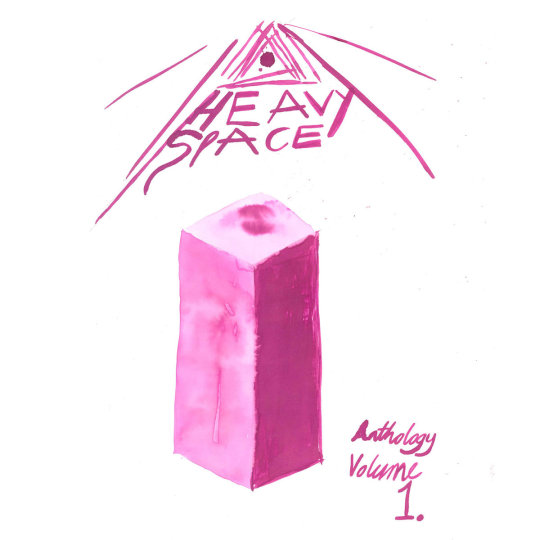
DURA Reverberation Hymns cassette (Garden Portal)
JODIE LOWTHER The Cat Collects download (self-released)
WOLKOROTS Dan Manialogism cassette (Magma Tones, Finland)
CEREAL KILLER The Beginning And End Of Cereal Killer (Anti Fade, Australia)
COLIN WEBSTER/MARK HOLUB Nadir (Raw Tonk, UK)
The CAVEMEN Lowlife 7” EP (Slovenly)
FRANCISCA GRIFFIN The Spaces Between cd (CocoMuse, New Zealand)
ANDY HUMAN & THE REPTOIDS “Psychic Sidekick” 7” (Total Punk)
SEI A Mode Static 12” (Aus Music, U.K.)
JOHN SAINT PELVYN Improvisation 7.7.18 download (Southern Jukebox Music)
REBEL SCUM The Descent cassette (chemical imbalance., Australia - 2018)
S. ARAW TRIO XIII Activated Clown cassette (NNA Tapes)

FERRAN FAGES & VASCO TRILLA Gestell cd (Raw Tonk, UK)
HUA LUN Wanderlænd + 2 cassette (Katuktu Collective)
VIRVON VARVON Mind Cancer cassette (Girlsville)
PHILIPP OTTERBACH The Rest Is Bliss (Knekelhuis, Netherlands)
EDITRIX Talk To Me download (self-released)
PAVLOV’S PUSS Comfort Food (Melted Ice Cream, New Zealand)
NATHALIE STERN Nerves And Skin cassette (Cruel Nature, UK)
AKI TAKASE Hokusai cd (Intakt, Switzerland)
MOORDDROOM Deep VR Edits bandcamp DL (New York Haunted, Netherlands)
EXEK Some Beautiful Species Left (Digital Regress)

CLAIRE BIRCHALL “Dead Air” bandcamp DL (it, Australia)
JUDY & The JERKS Bone Spur cassette (Earth Girl) & Music For Donuts ep (Thrilling Living)
POWER STEERING Power Steering cassette (chemical imbalance., Australia)
RASMUS TIETCHENS HOBOTPAHC cd-r (New York Haunted, Netherlands)
UTINUTIN Black Cat, Anyeurism, And Simian Politics download (no label)
GUY BIRKIN Yemen Data Project cassette (New York Haunted, Netherlands)
LINUS VANDEWOLKEN Het Vlier Een Hommel Op Aarde 10”x 2 (Okraïna, Belgium)
JOHN CHANTLER Tomorrow Is Too Late (Room40, Australia)
JENNIFER VANILLA J.E.N.N.I.F.E.R. EP 12” (Beats In Space)
WOW Come La Notte (Maple Death, Italy)
KATE MOHANTY Disappear Here cassette (Friendship Tapes)
ASTRO SOCIAL CLUB & GRUMBLING FUR Plasma Splice Trifle (vhf)
SANR Kesif cd (Flaming Pines, UK)

ANDREW TASSELMYER & PATRICK SPATZ Interior Currents cassette (Constellation Tatsu)
AHMEDOU AHMED LOWLA Terrouzi cassette (Sahel Sounds)
SKRU Count Zero cassette (Bedouin, UAE)
PUGILIST Blue 06 12” (Whities, UK)
ULAAN KHOL Collapsing Hymns cassette (Worstward)
L.$.D. FUNDRAISER No Peace Without Tranquility (no label, New Zealand)
COCHONNE Cochonne (self released)
LE POUFS À CORDES Le Poufs À Cordes cd (Pagans, France)
FRET! A Vanity Spawned By Fear cassette (Cruel Nature, UK)
UNWAR Other People cd-r (Magma Tones, Finland)
WOJCIECH RUSIN The Funnel (Akashic, Scotland)
SLEEPER AND SNAKE Junction And High (Aarght, Australia)
The OILIES Psychic Dog (Fruits & Flowers)
ELI KESZLER Empire 12” (Shelter Press, France)
HAIDER 10961 12” (Aus Music, UK)
FOSTER CARE El Abuso (Total Punk)
TORN HAWK Time Is A Scam 2x 12” (L.I.E.S.)
The LICE Nancy Spungen download (self-released)
DJ XNX ATX (Get Busy!, Russia)
SHITTY LIFE Vinyls Discography (Lo-Fo Lo-Life, Germany)
GONG GONG GONG 幽靈節奏 = Phantom Rhythm (Wharf Cat)

SARAH LOUISE Nighttime Birds And. Opening Stars (Thrill Jockey)
MYRIAM BLEAU Lumens & Profits (Where To Now?, UK)
TV DUST Forget (MyOwnPrivateRecords / Occult Gang, Italy)
PRIMORJE Reference Path cassette (Thalamos, Greece)
JUNE CHIKUMA Ler Archives LP + 7” (Freedom To Spend)
dMyanche Ergonomie cassette (Indian Redhead, France)
EQUIPMENT POINTED ANKH Live (Sophomore Lounge)
VIV CORRINGHAM Until I Learn The Language Of Mineral Vegetable cassette (Linear Obsessional, UK)
JACOB WICK feel (Thin Wrist)
AMATEUR HOUR Framtiden Tillhör Inte Oss (Happiest Place, Sweden)
The FICTIVE FIVE Anything Is Possible cd (Clean Feed, Portugal)
DANKETSU 9 Towards A Walk In The Sun cd (Patient Sounds (intl))
IVAN THE TOLERABLE Rations 2LP (Stolen Body, UK)
DANA Glowing Auras And Black Money (Heel Turn)
NATE YOUNG Volume 3: Dance Of The Weeping Babe 12” (Lower Floor)
SHOLTO DOBIE & MARK HARWOOD The Blue Horse cd (Penultimate Press, UK)
HEAVY METAL 4 (Statik Age Music, Germany)
WET TUNA Water Weird (Three Lobed Recordings)
CARRAGEENAN Invisible Design cassette (Czaszka, UK)
PRIVATE ANARCHY Central Planning (Round Bale Recordings)
HIDEO NAKASAKO Texture Of Days cassette (Muzan Editions, Japan)
PRANA CRAFTER Bodhi Cheetah’s Choice (Beyond Beyond Is Beyond)

PATRICK SHIROISHI & NOEL MEEK Break Your Eyes cassette (Sploosh)
ANDY HUMAN & The REPTOIDS Psychic Sidekick (Total Punk)
SLAG QUEENS You Can’t Go Out Like That (Rough Skies Records, Australia)
ALIAS G Natural Love 12” (Unknown To The Unknown, UK)
NIVHEK After Its Own Death / Walking In A Spiral Towards The House cd (W.25th)
GARCIA PEOPLES Natural Facts (Beyond Beyond Is Beyond)
MARCO SERRATO/FRANCESCO COVARINO Bestemmia cd (Raw Tonk, UK)
HOUSEWIVES Twilight Splendour (Blank Editions, UK)
CLOUDWATCHERS Cloudwatchers cd (Unexplained Sounds Group, Italy)
CATHERINE LAMB Shade/Gradient (Black Pollen Press -2018)
UNITED BIBLE STUDIES Porti Sepolti cassette (Sloow Tapes, Belgium)
ÚJ BÁLA Diacritical Marks And Angels cassette (Baba Vanga, Czech Republic)
STRENGTH N.I.A. Do Televisions, Frankie Moore ritual cassette (Stength N.I.A., UK)
DAVID LIPTAK David Lipton: Dove Songs [Tony Arnold, soprano/Allison D’Amato, piano] cd
ANNĒE ZĒRO La Coolitude (Indian Redhead, France)
MELENAS “Ya Me No Importa Si Tú Quieres”/“Si Tú Me Quieres” 7” (El Nebula Recordings, Spain)
WHIRLING HALL OF KNIVES Knukke cassette (Cruel Nature, UK)
PROTRUDERS Poison Future (Feel It)
MOTHER JUNO Commit cassette (popnihil)
LEFT HAND CUTS OFF THE RIGHT Purge cassette (Fractal Meat Cuts, UK)

CLAIRE ROUSAY t4t cassette (No Rent)
IQ+1 Conversaphone Plus (mappa, Slovenia)
BENOÎT PIOULARD & SEAN CURTIS PATRICK Avocationals (Bacon Sound)
DELPHINE DORA Dunkles Zu Sagen (self-released)
SOOT Pockmarked With...Soot! cassette (Eternal Soundcheck, Australia)
DAN MELCHIOR BAND Negative Freedom (In The Red)
TÔLE FROIDE Tôle Froide (Le Turc Mecanique, France - 2018)
AHMED AG KAEDY Alkaline Kidal (Sahel Sounds)
DUNNING & UNDERWOOD The Blow Vol. 5 cassette (Front & Follow, UK)
TAKAHIRO MUKAI Super Annoying cassette (Fort Evil Fruit, Ireland)

ANTONIO High Voltage! cassette (Altered States Tapes, Australia)
CUBE Decoy (W.25th)
The PLAINS The Plains cassette (chemical imbalance., Australia)
KA BAIRD Respires (Rvng Intl.)
GINO & The GOONS Do The Get Around (Drunken Sailor, UK)
VIVIEN LE FAY Ecolalia (Boring Machines, Italy)
DUKE Uingizaji Hewa (Nyege Nyege Tapes, Uganda)
ARIAN SHAFIEE Arabic Voice cassette (unifactor)
MOUNT TROUT Shelter Belt cassette (Rough Skies, Australia)
OCEAN FLOOR Vernalis cassette (Eiderdown)
CURRENT AFFAIRS “Buckle Up”/“World In Crisis” 7” (dotx3, Germany)
AARON SNOW Instrumentals ‘15-‘19 cassette (Surf Shop)
MELKINGS Movement Music cassette (Regional Bears, UK)
DECIMUS DECIMUS 6 (self-released)

SYLVIE COURVOISIER and MARK FELDMAN Time Gone Out cd (Intakt, Switzerland)
DANIEL HOLT Daniel Holt 12” (L.I.E.S.)
BEAT DETECTIVES NYPD Records Volume 3: Nefertiti Abstract Movie cassette (NYPD Records)
STEFAN CHRISTENSEN & FRIENDS Unknown Fortune (C/Site)
DIRE WOLVES Grow Towards The Light (Beyond Beyond Is Beyond)
FAMOUS LOGS IN HISTORY Memories Of the Space Age cassette (Fuzzy Warbles Cassettes)
HAND & LEG Lust In Peace (Black Gladiator)
DEE DEE & The FUZZ COFFINS Three Golden Hits cassette (Earth Girl Tapes)
RAZORLEGS Skip Skool cassette (Fadensonnen)

BEST REASONS TO WRITE FUCKIN’ RECORD REVIEWS IN 2018
BEST REASONS TO WRITE FUCKIN’ RECORD REVIEWS IN 2017
BEST REASONS TO WRITE FUCKIN’ RECORD REVIEWS IN 2016
BEST REASONS TO WRITE FUCKIN’ RECORD REVIEWS IN 2015
BEST REASONS TO WRITE FUCKIN’ RECORD REVIWS IN 2014
BEST REASON TO WRITE FUCKIN’ RECORD REVIEWS IN 2013
youtube
Neil Morris, speaking to Alan Lomax in 1959:
“Well, when I was just a small boy, Old Uncle Milt Oldfield…Billy Oldfield, the Congressman from Arkansas for so long, it is his father. He and my father are awfully close friends. And they were discussing music. They were music teachers both of them.
“And uh, and they said, dad did and Uncle Milt sanctioned what he said, that MUSIC HAD NO END. That you could learn all the other guy [or girl] learned, and after you got that done they would then, something else would crop up. That uh, that you, that was the reason why that uh, music advanced. That’s why that you would get a better music in one generation maybe that is, uh, IT WOULD FIT THE TIMES IN WHICH THEY LIVED.”
[Lomax: “What about music on the grapevine?”]
“Welllll, they said that MUSIC GREW LIKE THE GRAPEVINE THAT IS NEVER PRUNED. That each year it’d…it’d put on a little bit more. That was what they said, now, about it. Any further questions?”’
#Best Reasons To Write Fuckin' Record Reviews In 2019#Taiwan Housing Project#Samantha Riott#2019#Possible Humans#Paula Garcia Stobne#William Henry Meung#Leila Boudreuil#Leighton Craig#Knitted Abyss#Weak Signal#Tom Of England#Dry Cleaning#75 Dollar Bill#Dark Blue#Kali Malone#Shabazz Mystik#Long Hots#Amirtha Kidambi#Lea Bertucci#Chris Brokaw#Spiral Wave Nomads#Hama#YL HOOI
39 notes
·
View notes